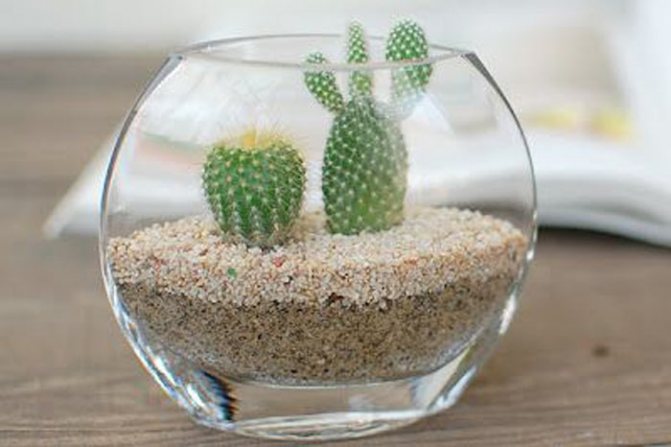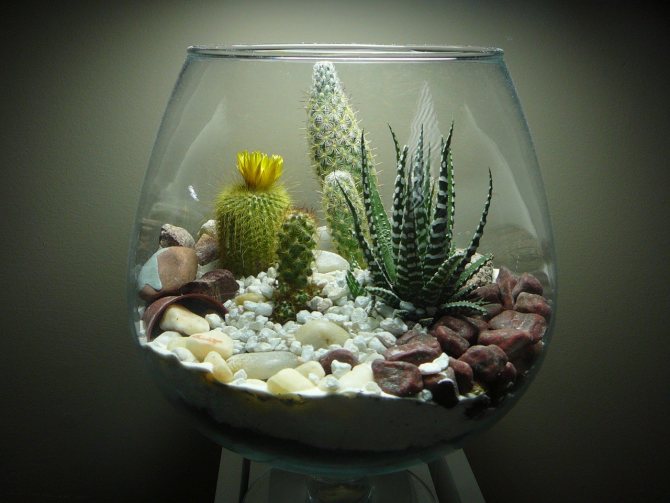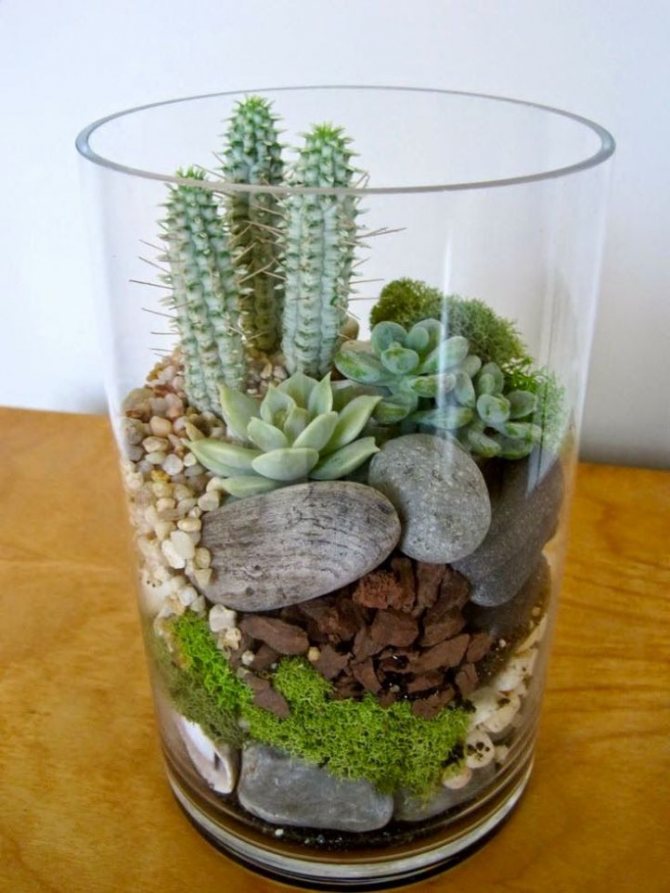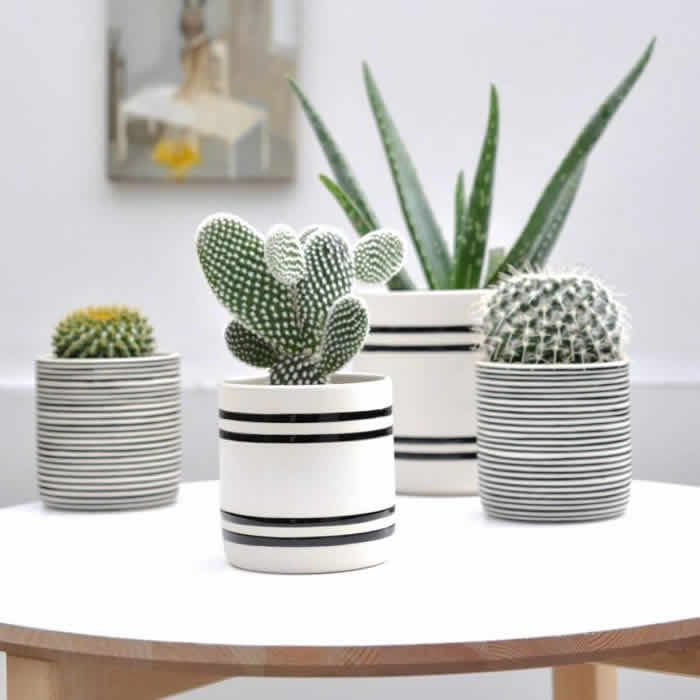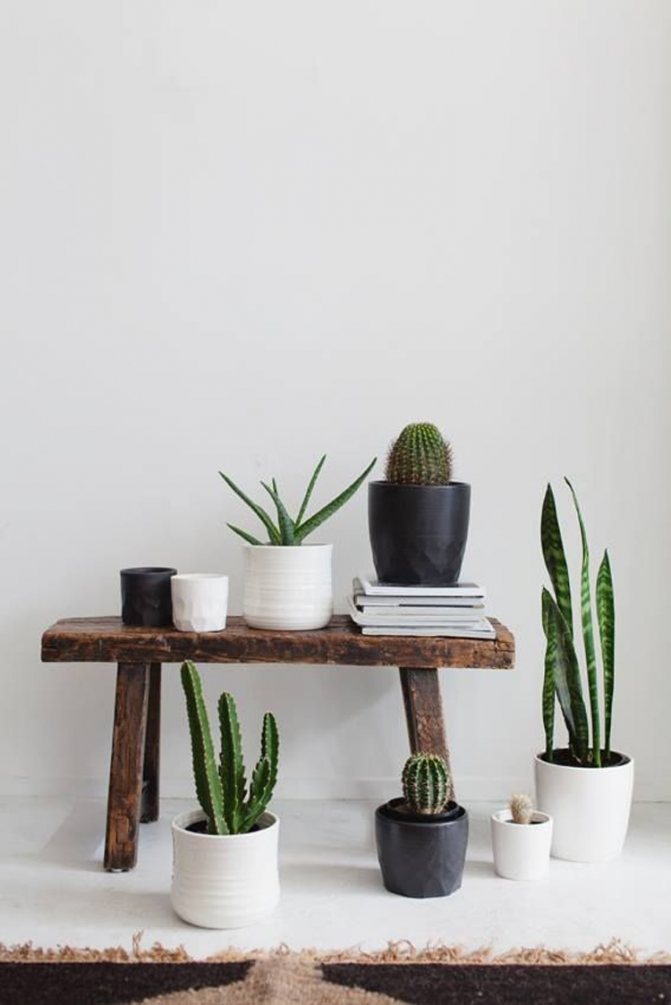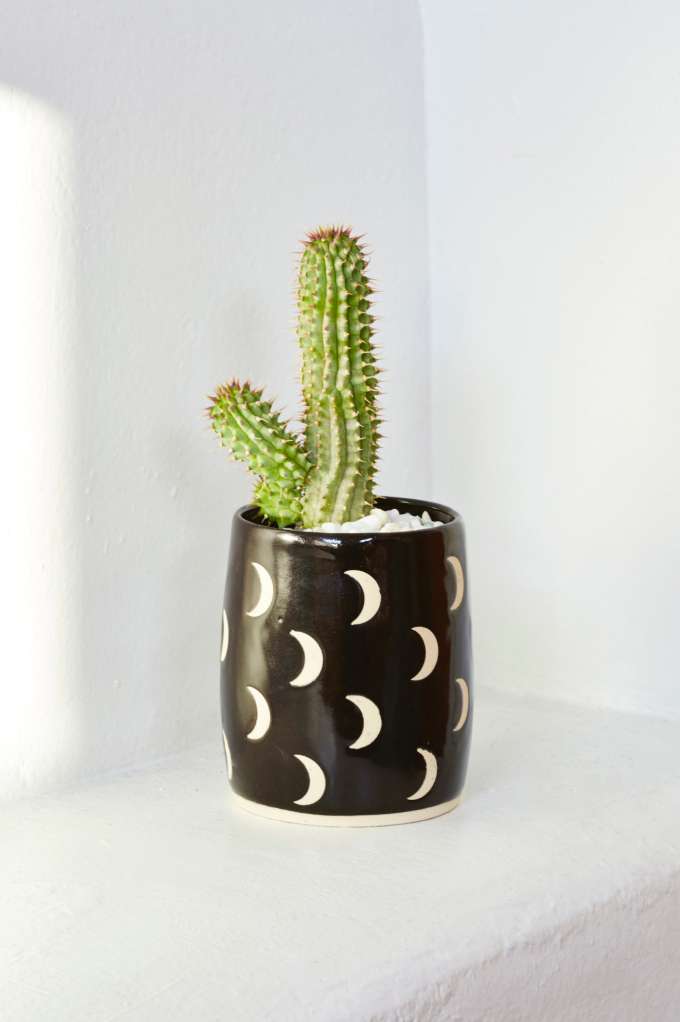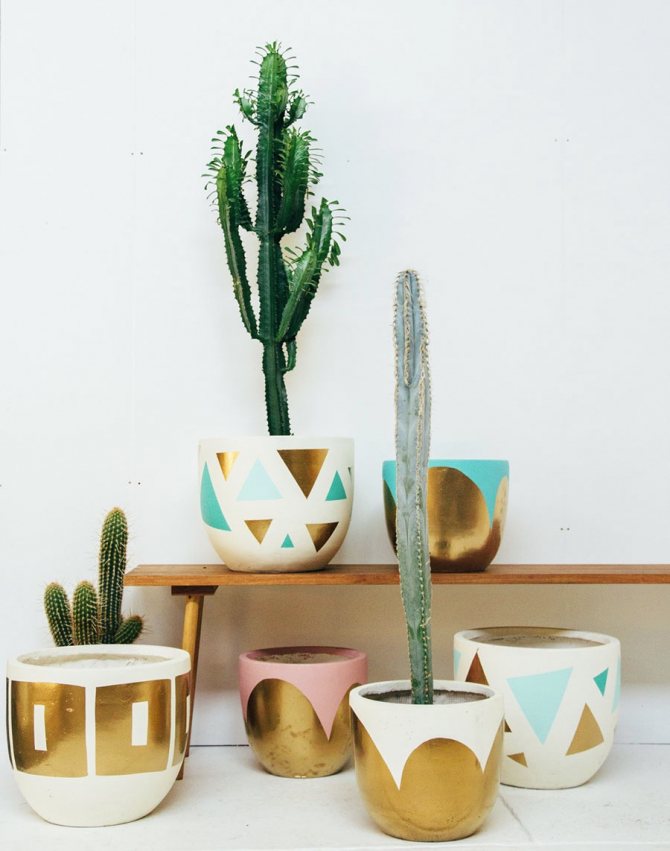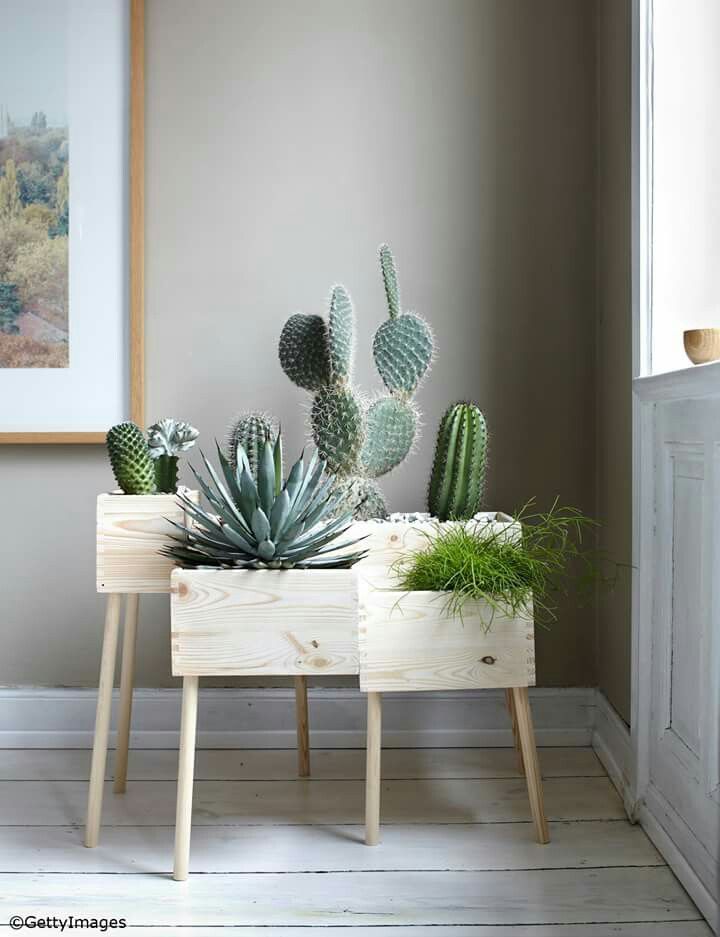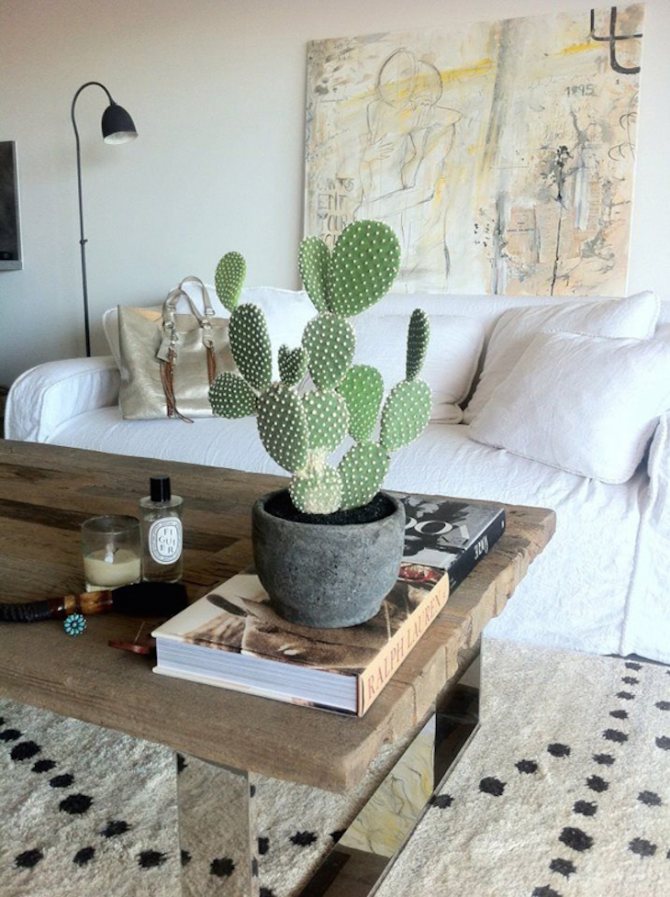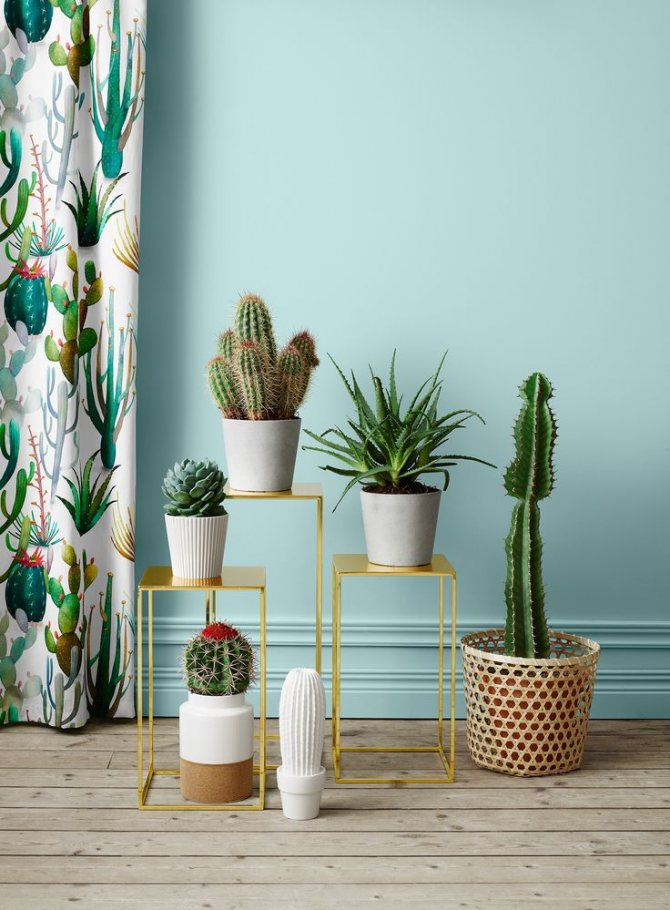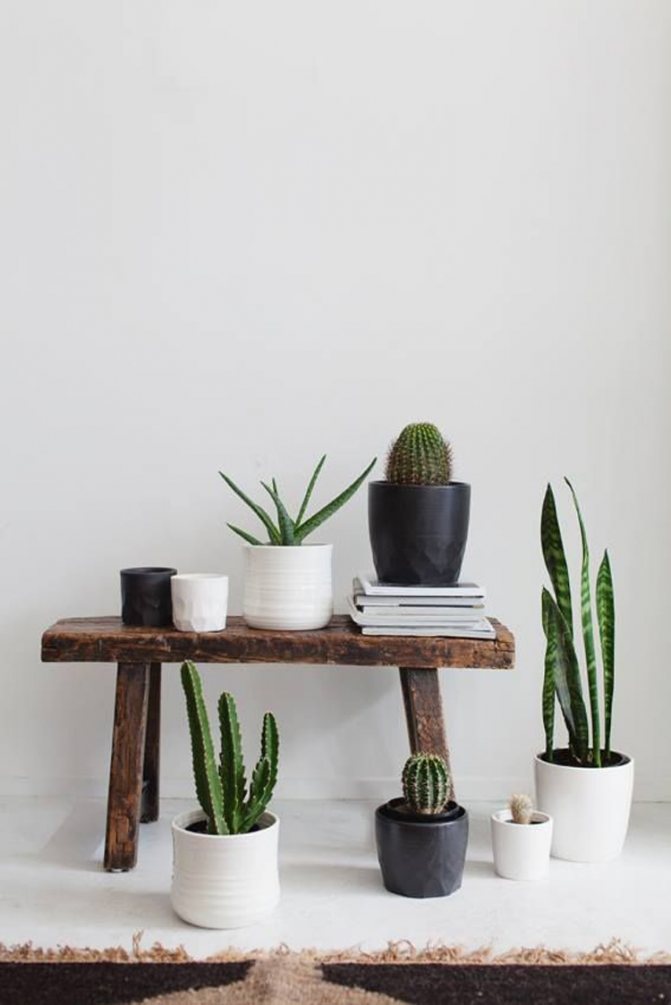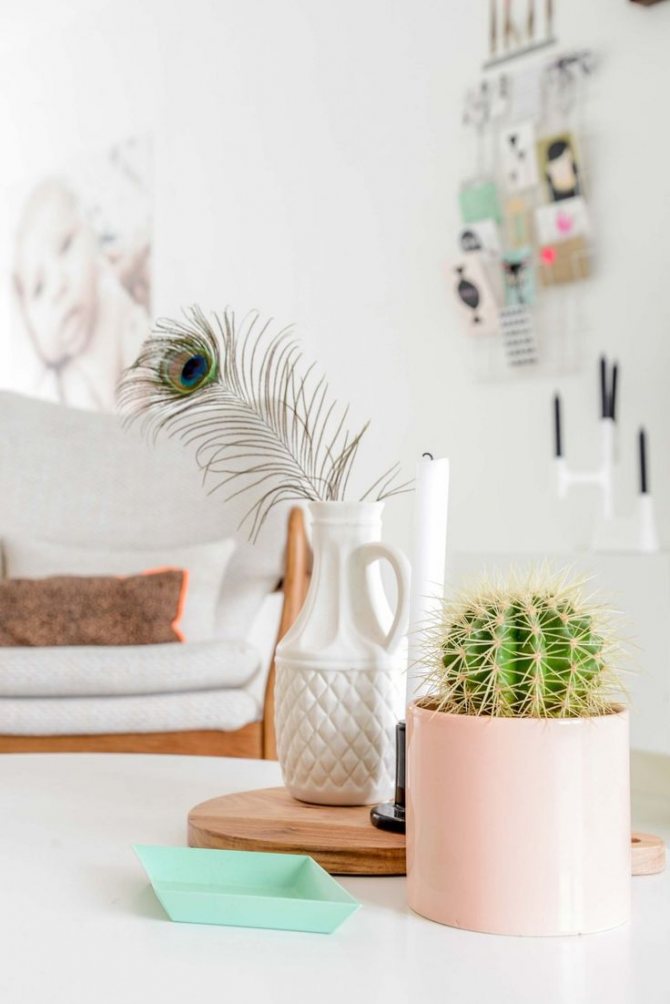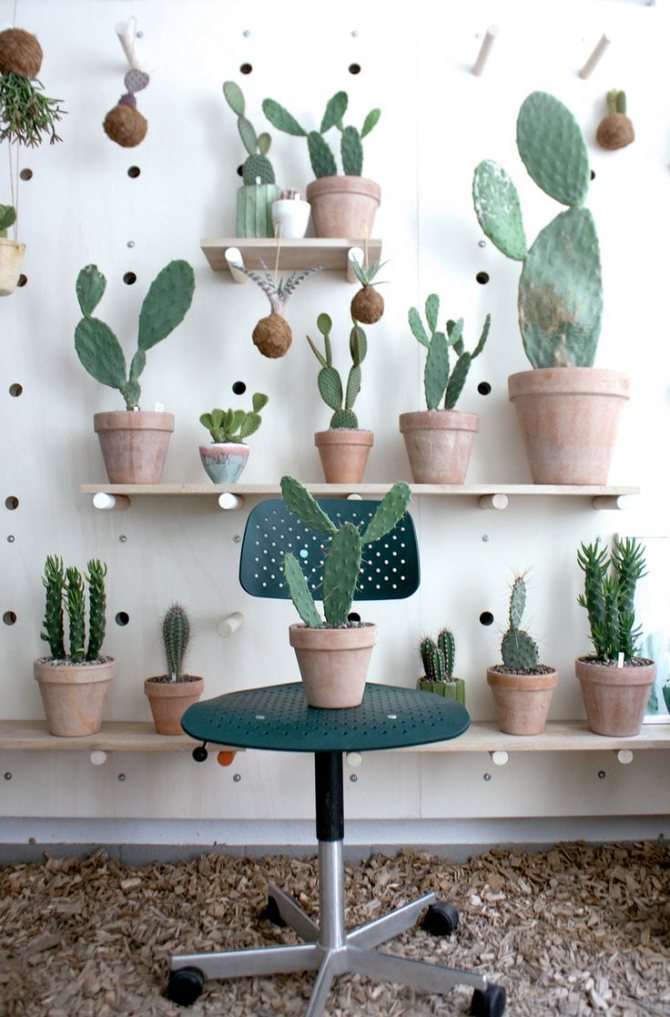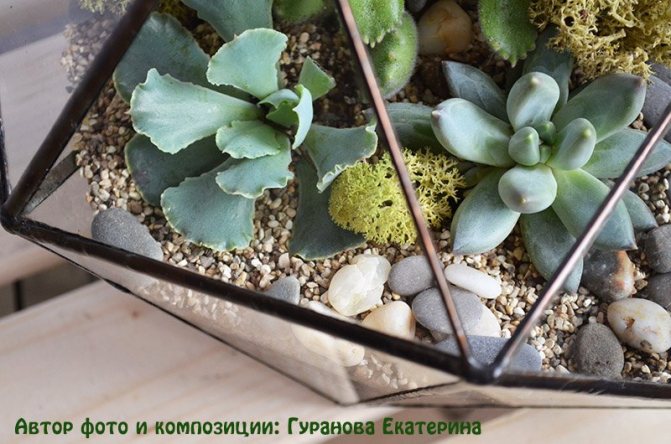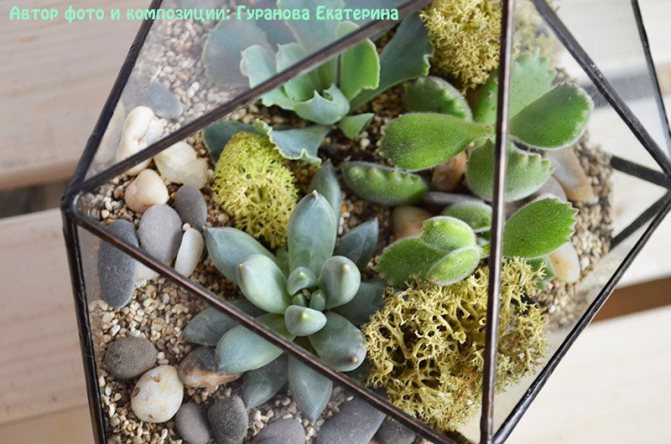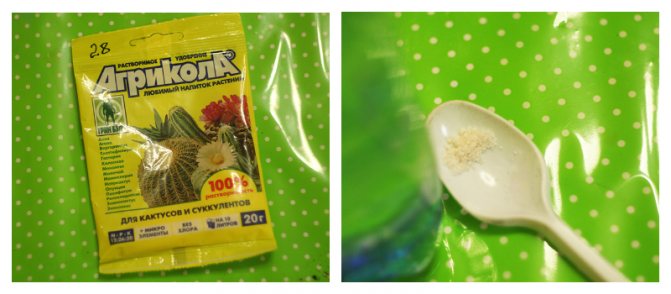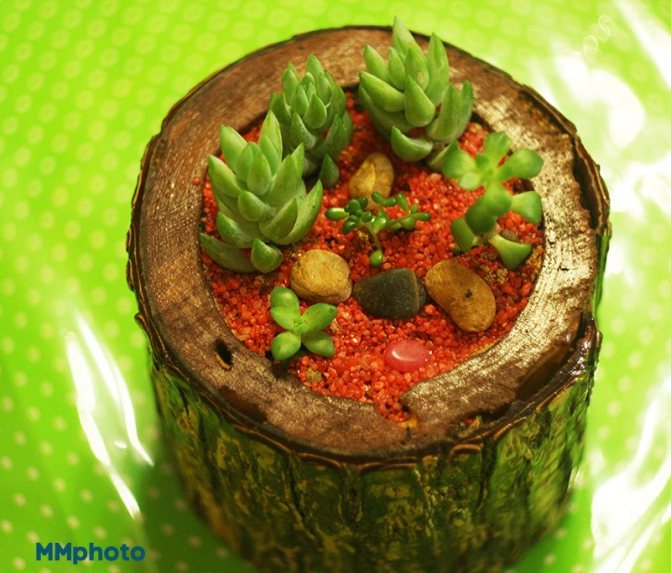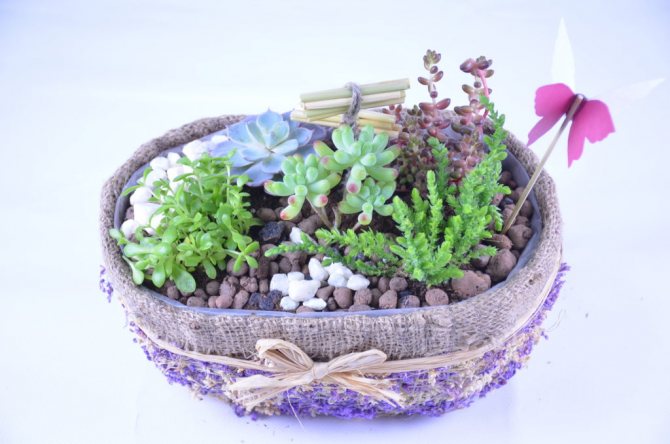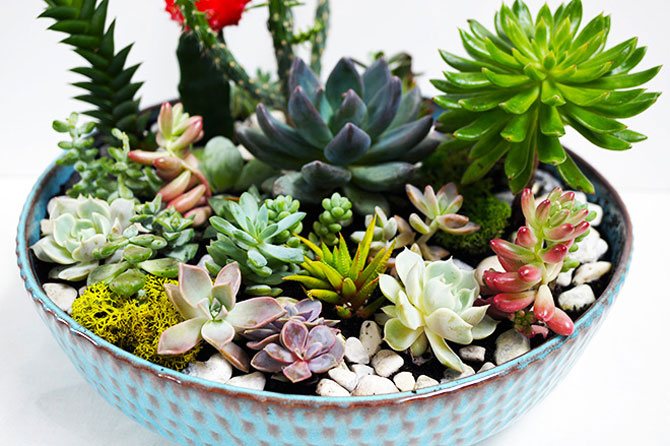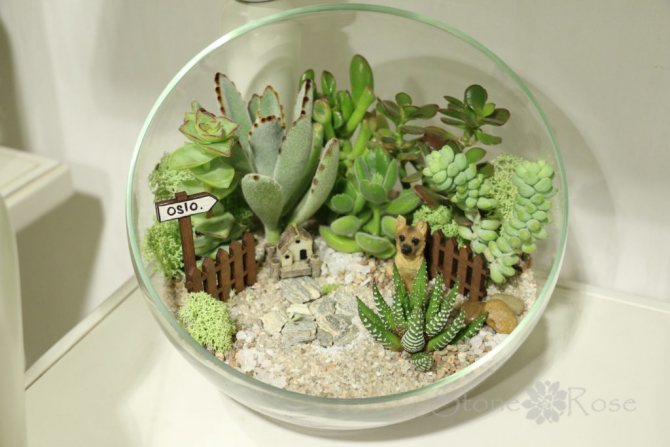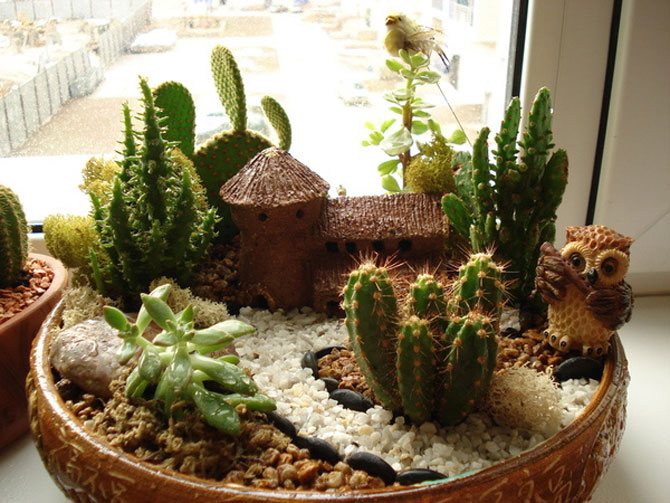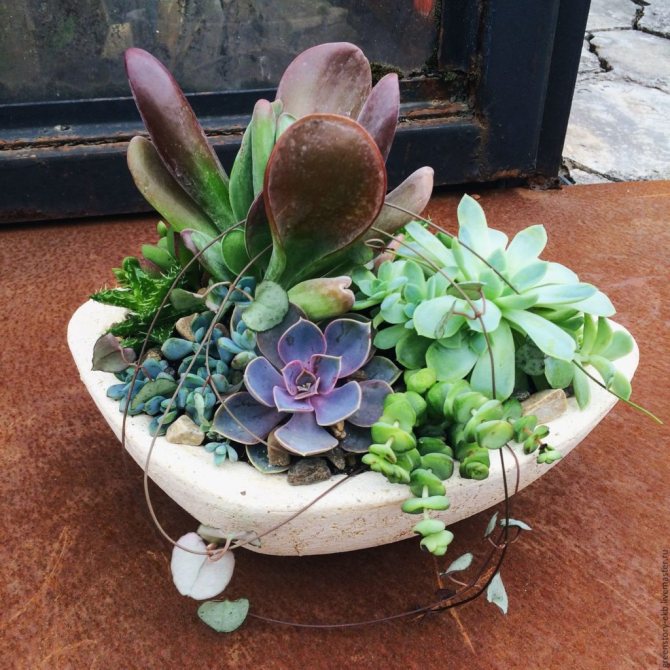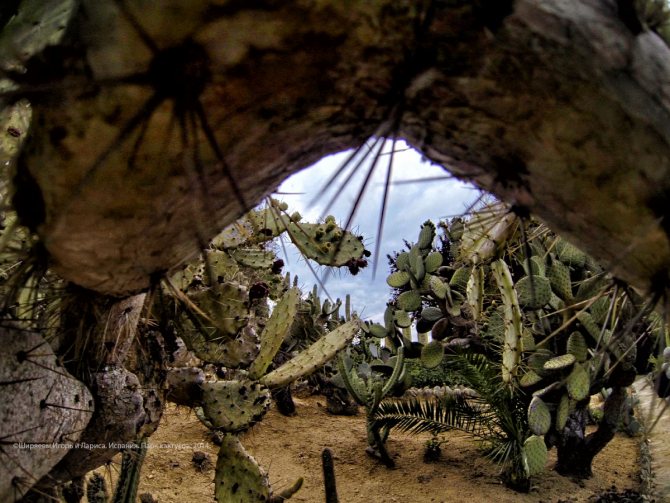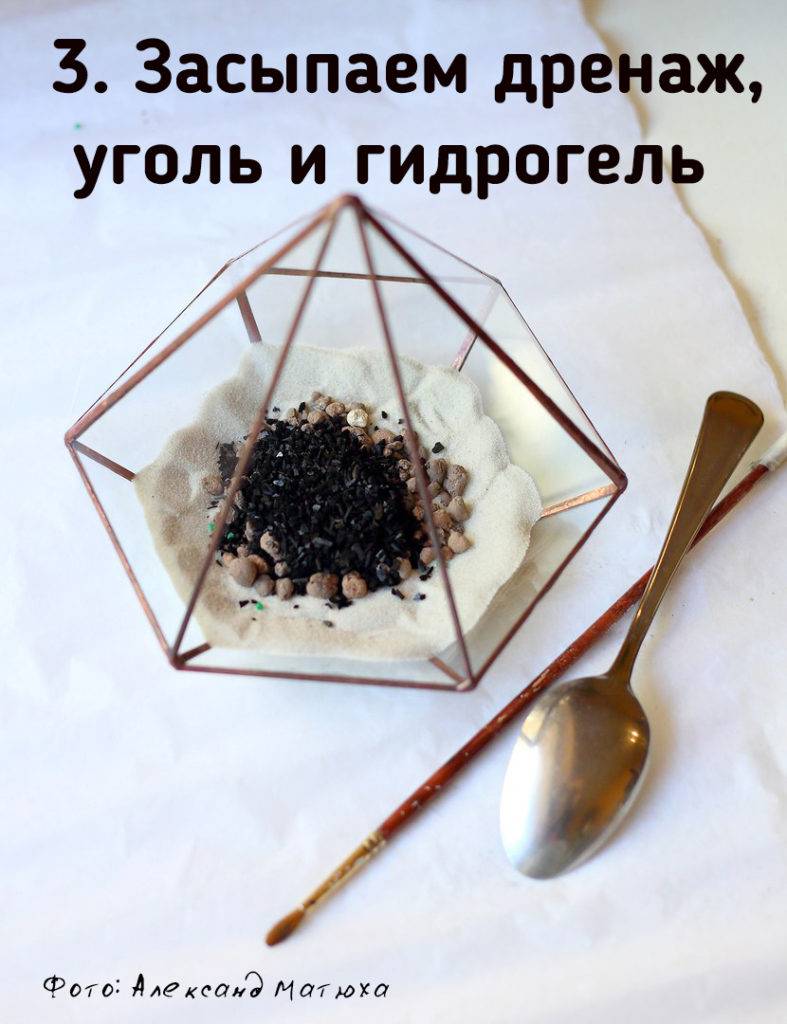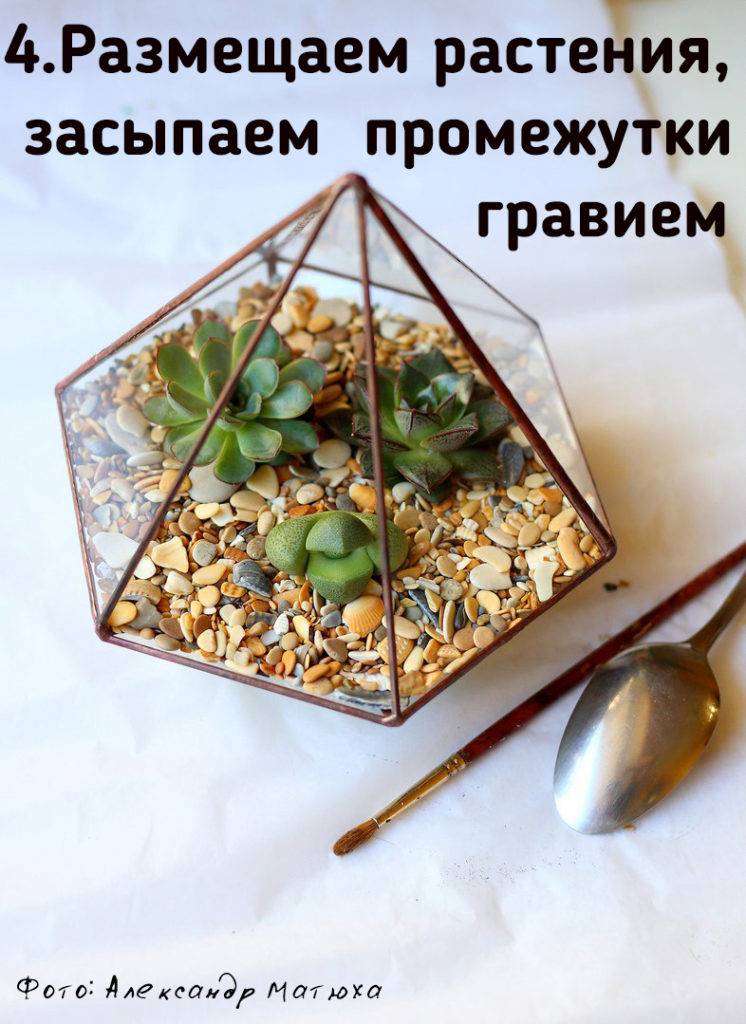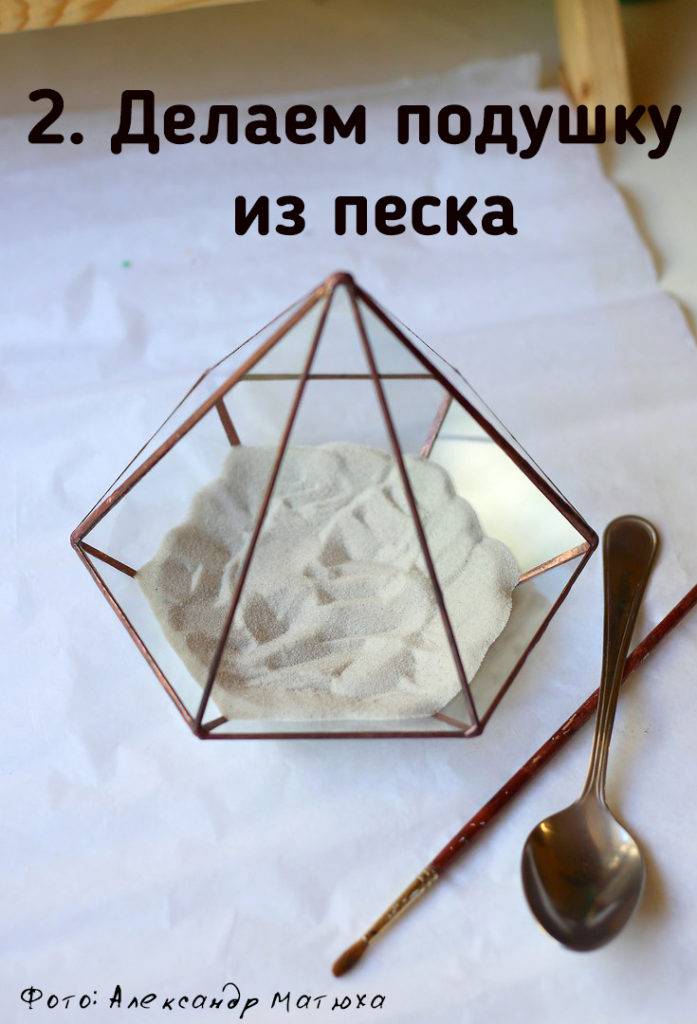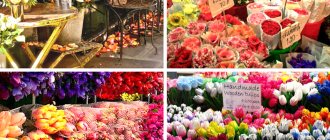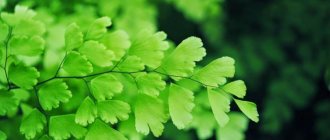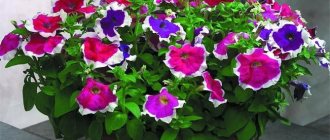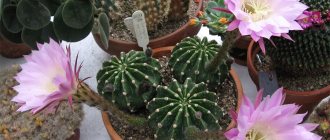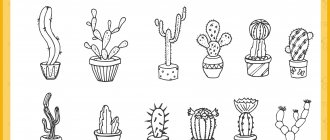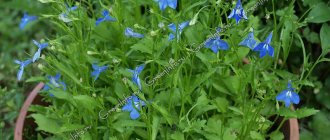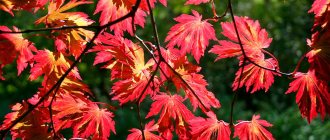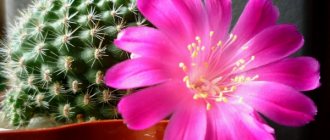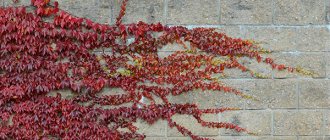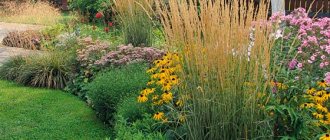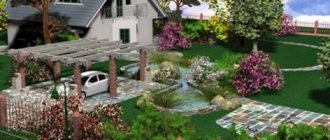What it is?
Succulents are plant species that have the unique ability to store water in their tissues. Therefore, they are adapted to an arid climate. Succulents come in 2 varieties.
- Stem accumulate moisture in a thick stem, the leaves of such plants are most often very small or they are thorns. These varieties include the bulk of cacti and some types of milkweed.
- Leafy accumulate moisture in dense thickened leaves. Of these succulents, aloe, lithops, haworthia, echeveria are especially popular.
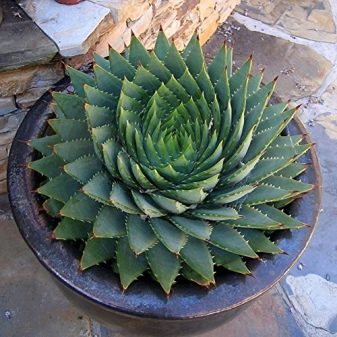
It is from these specimens that succulent growers make chic compositions and decorate entire zones. Unique feature hold moisture for a long time greatly facilitates the care of plants. They are especially eagerly used by people who, for various reasons, cannot regularly take care of plants, for example, because of frequent business trips.
Succulents are so convenient in this regard that you can completely leave on vacation and, upon your return, find your pets safe and sound. And if it so happened that the plants did not receive water for a long time, another feature saves them: the top may die, but new stems will grow back when watering.
When decorating housing with these plants, it should be borne in mind that the juice of many of them is poisonous, and the surface of some species is covered with thorns or thorns.
Therefore, when working with them, you need to act carefully, it is better to protect your hands with gloves.
Subtleties of care
Caring for a florarium with succulents is minimal - these plants love moisture and light, but are not demanding for watering. It is more difficult to care for a composition with flowering plants, since they need a regular supply of fresh air, shade and an optimal temperature. Any greenhouse must be watered and fed.
Lighting
It is undesirable to place florariums under direct sunlight, even with thermophilic plants. According to the principle of action, such compositions are similar to greenhouses, and direct sunlight sharply increases the temperature inside and disrupts the vital activity of plants.
If there is not enough light, which can be understood by the yellowness on the leaves, a sick plant species, it is necessary to organize the backlight. You can use an ordinary fluorescent lamp, which is not located on the side, but above the container.
Aquariums have lighting built into the lid. They can also be used, but not permanently.
In summer and spring, place the greenhouse on a windowsill or table in the northern part of the room, and in autumn and winter, closer to sunlight. But never place containers next to batteries or other heating appliances.
Temperature
Most of the plants used for mini-greenhouses are thermophilic, therefore they tolerate the high air temperature in the room well. In general, succulents and flowering specimens grow well at a temperature of + 22-28 ° C, many varieties tolerate a decrease in temperature to +10 degrees and below.
Humidity
In their natural environment, cacti, fat women, rejuvenated and other plants suitable for a vegetable terrarium grow in conditions of low humidity in deserts. With frequent or irregular inflows, rotting can begin in the roots and ground parts.In addition, the decorativeness of the composition deteriorates significantly - drops of condensation and putrefactive plaque appear on the walls inside.
Plants are watered no more than 1-2 times a week, focusing on the degree of soil drying. Through transparent glass, you can see that the soil or moss is dry, shriveled. In this case, it is necessary to water the soil over the entire area, trying not to get water on the inner walls of the vessel. The soil should be saturated, but no water should accumulate in the drainage layer. If you have poured a lot of liquid, gently tilt the container and, using paper towels, scoop out the excess moisture.
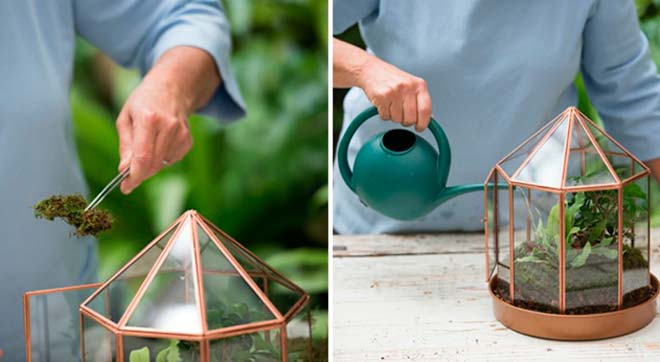

As water for irrigation, use settled or filtered room temperature. When growing plants in open containers, spraying is recommended 1-2 times a week. Using a spray bottle, gently spray the parts of the plants in the upper half of the container. You can also use a household humidifier.
A miniature greenhouse in glass with trees, flowering plants, cacti is not just another fashion trend, but an original decoration of an apartment or office that will not leave anyone indifferent.
Varieties
Long gone are the days when a cactus was sadly gathering dust in a pot and did not represent anything attractive. Now, florist designers and lovers of these species have learned to create real miracles and create mini-gardens at home using plants and various decorative elements.
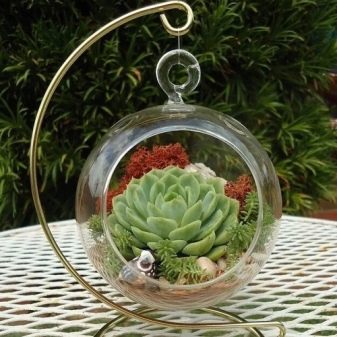

Phyto paintings
To create a living picture, need a frame, which should be deeper than those for ordinary paintings. Everyone chooses Rama according to their taste. In a horizontal view, it will be a flat box, at the bottom of which there is plywood, and along the edges there are sides.
Next, the substrate is laid in which the flowers will grow, and a metal grill is placed on top... Thus, each plant will have its own cell. Considering that succulents have a wide variety of colors, you can create a very beautiful picture and feel like an artist painting with real flowers.
A small succulent is sent to each cell. When all the cells are filled, it is necessary for the painting to settle in a horizontal position for 2 weeks. After the plants take root, you can place your DIY masterpiece on the wall. Periodically, the painting can be sprayed or organize monthly watering, after removing it from the wall.
After watering, it is better to leave it in a horizontal position for several hours, and then return it to the wall.
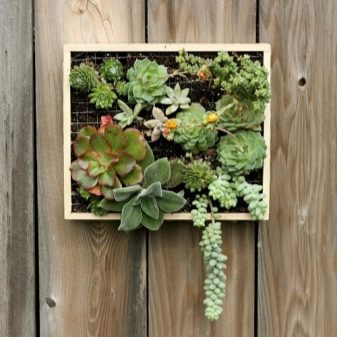

Panel
A panel of living plants is the same picture. And the manufacturing principle is exactly the same. You can add decorative elements as desired, and also choose a different shape. For example, make a very narrow horizontal or vertical design, round or oval.
If someone has a desire to make a panel of dried plants, then they simply attached to the base with glue or varnish, from above they can also be varnished. Such panels do not need care at all, but they perfectly decorate the interior.
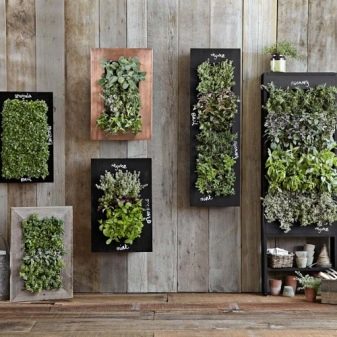

Compositions in pots
Everyone has the opportunity to equip their own miniature garden at home. To do this, it is enough to pick up several suitable pots and plant plants in them. You just need to decide on the shape and color of the pots and the types of plants that will decorate the composition. They can be placed on any surface and even on the floor. In addition, a mini succulent garden can be made in one large pot.
Many miniature plants of different colors and types will create a wonderful composition.
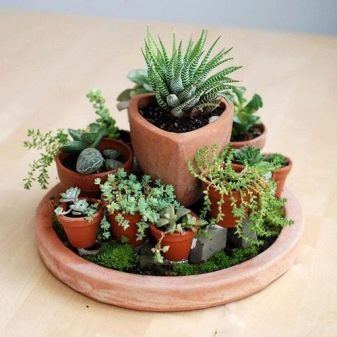

Florariums
Succulents in glass look especially interesting and original. Florariums most often created in aquariums... They look very nice in a round aquarium. Several types of plants are planted in it, supplemented with stones and other design elements to your taste.
You can install such a glass vessel anywhere. It will decorate the window sill, but not from the sunny side, and the chest of drawers, and the shelf, and the coffee table.
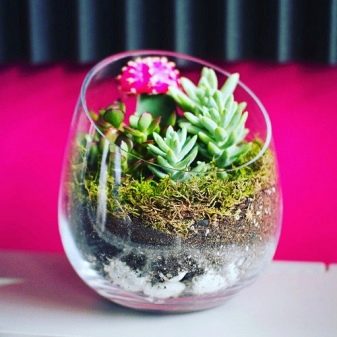

Basic principles of creating a composition
In order for the composition to be a complete picture, it is necessary to follow some rules.
Decorative powder
The powder will help not only to complement the decorative "landscape" with original details, but also perform a completely practical function.
Due to the fact that most often the pallets and pots for them are used small and are placed in sunlight, the roots can overheat. Additional coverage in this case will save the plants from stretching and pallor.
Compatible cacti and succulents
First of all, we are talking about representatives who are very similar in terms of caring for them. This will greatly facilitate the task of preserving the created mini - garden. The most hardy are echinopsis, mammillaria. They can coexist with almost all species and survive many cataclysms.
The correct pot
For a mini - garden with succulents, you can use your wild imagination to its fullest. Indeed, sometimes unimaginable objects are used as a pallet. Small plants look great in the most bizarre aquariums, in very small bowls and plates, and even in shells.
At the moment, these plants have been adopted by gardeners and landscape designers for vertical gardening.
Accents
In order for the composition not to look overloaded, the emphasis is placed on only one object or the whole view. All the rest should not be too conspicuous, but only complement and shade.
Composition composed mainly of echemeria Succulents in a hanging pot Using cacti together with a money tree Composition composed mainly of cacti Mostly green succulents in a beautiful pot Lithops in a pot Cactus composition with stones Various succulents in a pot Unusual composition of various succulents
Layout principles
To assemble a composition in a pot or glass vessel, one main principle operates: you need to imagine this composition and know how it should look, and not spontaneously place plants in a container. Anyone can make a composition, even a novice florist. It is performed step by step:
- first, you should choose a container in which the mini-garden will be placed: one pot or several small ones, an aquarium or other glass vessel, a picture frame or a flat box;
- then drainage is laid, a substrate is placed in which the plants will be comfortable;
- then the plants are placed in the selected container in the order that was predetermined so that they are combined in colors, sizes and correspond to the intentions of the artist who creates this small work;
- the final touch will be additions in the form of pebbles, twigs or small snags, hemp, sand and other decorative elements.
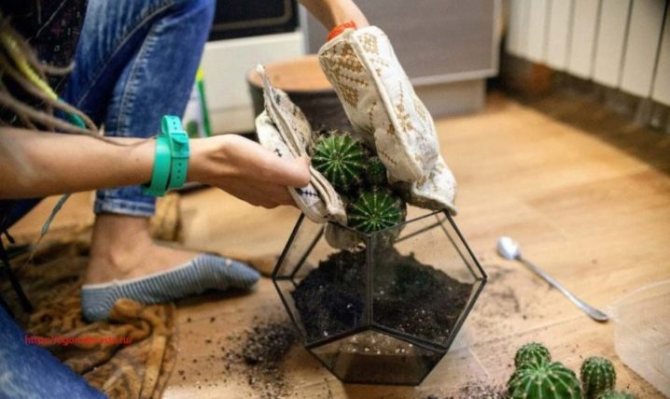

Place accents
The mini-garden, in which each plant "screams" about its uniqueness, brightness and unusualness, looks strange. Let all of them be amazing, but only a few types should come to the fore, and the rest should harmoniously emphasize them. If your composition is from succulents, then bring a tree plant to the background, for example crassula, euphorbia, staple, columnar cacti. The middle tier should be slightly lower, and the lower one can generally be made up of ground cover species, which will gradually hang effectively over the edge (you should think about a pot with a stem in the shape of a glass).
Plant selection
Choosing plants for one composition, you must follow the rules.
- We must focus onso that succulents have the same requirements for soil, watering, sun. Then the composition will be easy to take care of, and it will delight the eye for a long time.
- If the growing zone the selected plants have approximately the same or their habitats are in the same climatic conditions, then their neighborhood in the composition will be successful.
- When choosing components you need to ensure that too large specimens do not take food and moisture from small ones and do not harm their root system.
- Not recommended add a lot of mosses to the composition, since they have the property of retaining a large amount of moisture on the surface, which can damage the succulents. You can add very little moss for decorative purposes.
- Use you can use such succulents as sedum, rejuvenated, cotyledon, graptopetalum, argyroderma, aptenia.
Preparing for transplanting cacti
The best time to transplant cacti is late March, April, early May, i.e. when plants are just starting to grow. But if necessary, you can transplant cacti throughout the growing season. When transplanting healthy cacti with a noticeably grown root system, the new pot should be slightly larger than the old one. The old pot should be free to fit into the new one. If rotten or dead roots are found during transplantation, they must be carefully removed with nail scissors. In this case, the pot is taken a little less than the old one, and more sand and pieces of charcoal are added to the soil. Slow-growing cacti, which have grown little root system since the last transplant, can be planted in the same pot, just replace the soil with fresh one.
It is best to disinfect both the pots and the soil before replanting. Pots can be doused with boiling water, and the potting mix can be kept in the oven for about half an hour. Before transplanting, cacti are not watered for 2-3 days, because part of the moist soil will inevitably remain on the roots, and with injuries, cracks and breaks of roots, moisture quickly leads to decay. The soil mixture for planting should not be cold, dry, but may be slightly damp, but in no case soggy. Let me explain what slightly moist soil means - this is exactly the moisture that the soil bought in the store when opening the package has. It is not dry to dust, but when clenched in a fist, it slightly lumps, but quickly disintegrates.
The choice of capacity and substrate
The choice of capacity depends on the selected composition. If you use a lot of small and varied plants, then it is better to arrange it like a painting or place it in a flat box... If you want to focus on 2-3 species, you can place them in an aquarium or glass vase, decorating with additional elements. When creating an entire garden, it is better to place succulents in separate pots and arrange them so that they complement each other and decorate the space.
Succulents look good in earthenware... In addition, there are original solutions: plants can be placed in a wide glass on a thin leg, in an elegant high-heeled shoe, in a huge shell, in a beautiful box. Some make a garden in a piece of a sawn tree trunk. A real natural corner looks very beautiful and natural. The inside and outside of the wood must be treated with a water-repellent coating or special varnish.
Before planting plants, the bottom of any container must be laid out with stones. This will be the drainage. Then a layer of charcoal is needed. It is great for preventing the appearance of fungi. Next, the sand is mixed with a nutritious soil composition.
You can often find potting potting mix made specifically for succulents in garden stores.
How to plant a cactus
To remove a cactus from an old pot without hurting your hands on the thorns, it is very convenient to use plastic tweezers.But there is another way - the plant is wrapped in a strip of paper folded in several layers, then the pot with the plant is turned over, and lightly tapping on the bottom, it is taken out. As the famous Zaletaeva I.A. wrote, a healthy cactus must have a very strong root system, and it is defined as follows: if a cactus is taken by the trunk and lifted, then it must either rise with the pot, or be taken out of the pot with all the earthy clod, braided by roots. If the roots break, some of them will remain in the pot, and the rest will remain with the plant - then this is a sign that your cactus did not feel well, was sick. Most likely, some conditions of detention were violated, possibly waterlogging, which led to poor growth of the root system, or its decay and partial death.
Beautiful examples
Compositions can be very diverse.
- Such a wonderful corner can be created in a flat round container. A wooden house, colorful pebbles and small animal figures are perfect for succulents.
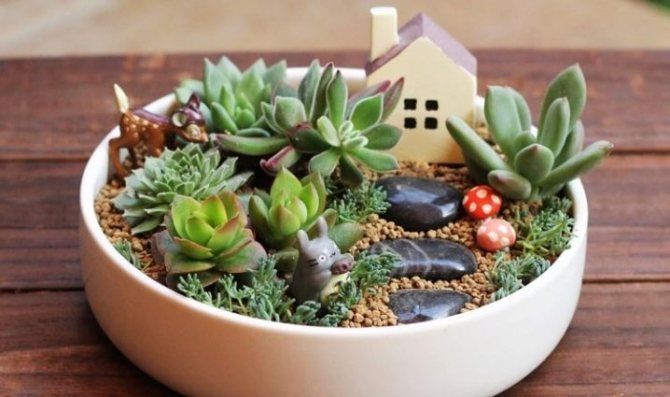

- A lovely rural landscape unfolds before your eyes in a wooden container with a fence and small cows. But the main elements of the composition are miniature plants of various colors.
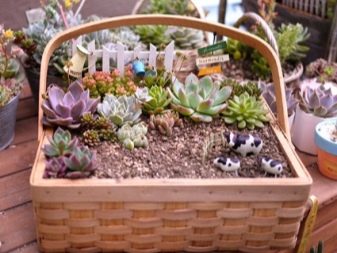

- Unlimited imagination will certainly prompt different options for interesting solutions: you can create an amazingly stylish composition even in an ordinary bank.
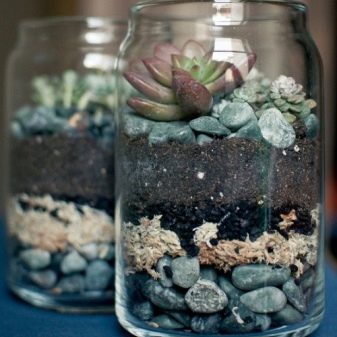

- With the help of succulents, you can make any thematic compositions, including New Year's ones. It is enough to add a few bright touches, for example, in the form of candles and balls.
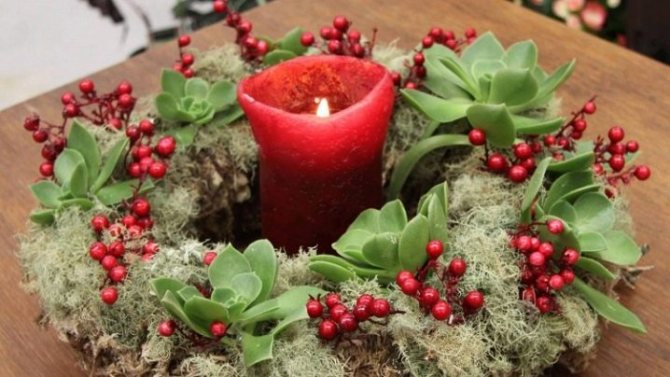

You can find out how to make a mini-garden of succulents with your own hands by watching the video below.
When an amateur florist already has sufficient experience in growing succulents and cacti, knows the peculiarities of caring for these plants, then you can try yourself in creativity. We are talking about compiling compact mini - gardens from a large and varied world of desert flora. This is a very fun process. And even if everything does not work out right away, you will get great pleasure. Everything is not so difficult if you listen to the advice of experienced florists.
Some potted succulents sometimes look boring and lonely. And in combination with other plants that are suitable for the care and conditions of maintenance, they will show themselves in all their glory.
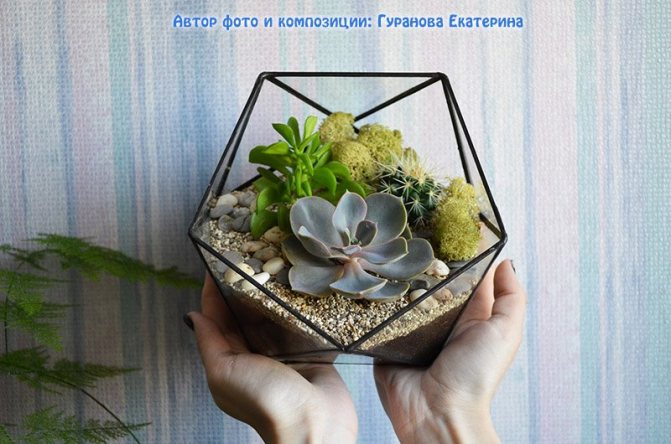

Carefully select cacti and succulent compositions
A master class is the best that can help you in this matter. Especially if you had no previous experience with plants, their taxonomy. Seek help from specialists, study thematic literature, since the modern variety is very large. From the general recommendations, it should be noted that plants should be selected as similar as possible in terms of care (watering, transplanting, growth rate, lighting, etc.). The proximity of cacti and succulents in this regard is not entirely true, but it looks impressive. To somehow neutralize the imbalance, choose the most hardy species: mammillaria, rebutia, echinopsis.
A composition of succulents and cacti of the same genus looks very beautiful. They are in harmony and unity, but meanwhile they differ from each other in shape and color. For example, lithops, or living stones. hoof-like, grow very slowly, so you do not have to transplant them for a long time.
Don't overdo variety. In a low pot with a diameter of 15-20 cm, it is best to plant 5-7 species, no more. Otherwise, the composition will be overloaded, and the plants will develop in cramped conditions.
How to make beautiful compositions?
Choice of capacity
First you need to roughly imagine: what kind of picture you would like to create - like a landscape or a composition that resembles an extravagant bouquet. The type of container in which the plants will be planted depends on this.Sometimes the compositions are created spontaneously, the flower grower accumulates a lot of children, scraps after the formation of a crown or bush, they are compiled into a single picture.
Aquarium: in round aquariums it is difficult to create a large composition. But everything is possible if you wish. First you need to disinfect the container. This can be done either with alcohol (just wipe it off) or with a chlorhexidine solution. At the bottom you need to pour crushed charcoal, preferably birch.
Charcoal absorbs organic residues and prevents mold growth. Then add drainage in an even layer (usually expanded clay) and the corresponding soil substrate. Since the aquarium is transparent, for beauty, you can alternate the soil with layers of colored sand. Then we plant succulents and cacti, depending on the plan.
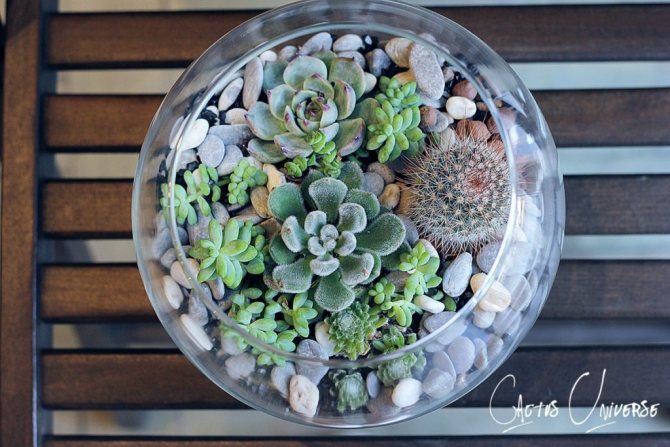

Clay vase - pots: it is better to use decorative vases with uneven, asymmetrical edges. There should be holes at the bottom for water to drain. The pallet must match the color and size of the pot. Pay attention to the color - it should match the plants. Clay is a hygroscopic material, so it is best suited for succulents. Pots with a broken edge, giant shells can also fit under a container for a mini-garden.
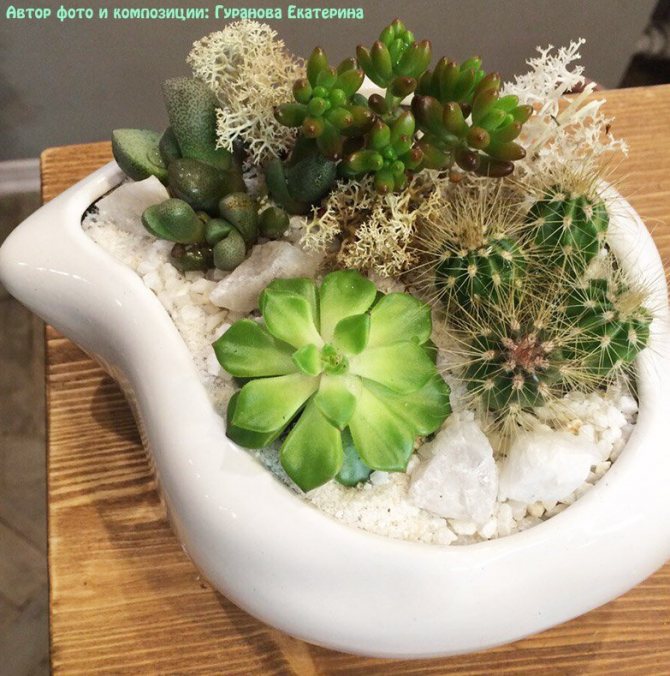

Glass vase: there are large glasses for chips on sale, as well as flowerpots with legs. They are treated in the same way as with aquariums. But it is very beautiful if you plant plants that will hang like vines from the edge of the flowerpot. In all cases, wherever an exotic garden is arranged, decorative details must be added: colored glass stones, small fortresses (such as are placed in an aquarium for fish), artificial moss, and others.
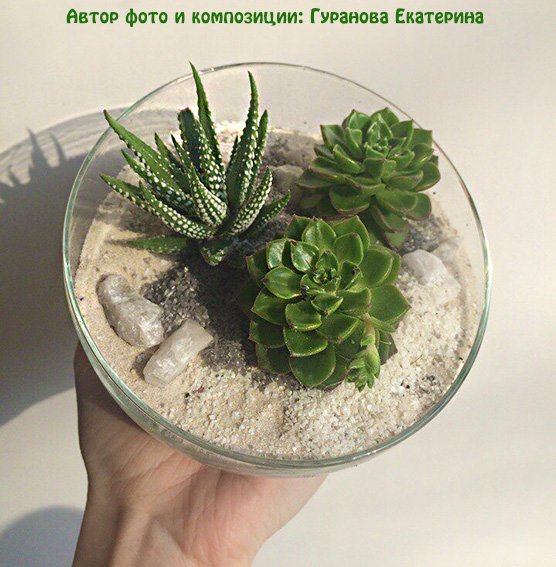

Wooden box or pot made from a piece of solid wood: this way is for true connoisseurs of flower eco-culture. The material is quite whimsical to care for, it requires a careful watering technique (such a pot cannot be wetted too much). If you decide to make a wooden container yourself, then before planting, be sure to cover it with a water-repellent varnish or wood impregnation. Such a pot will look amazing in any interior, delighting you and your guests!
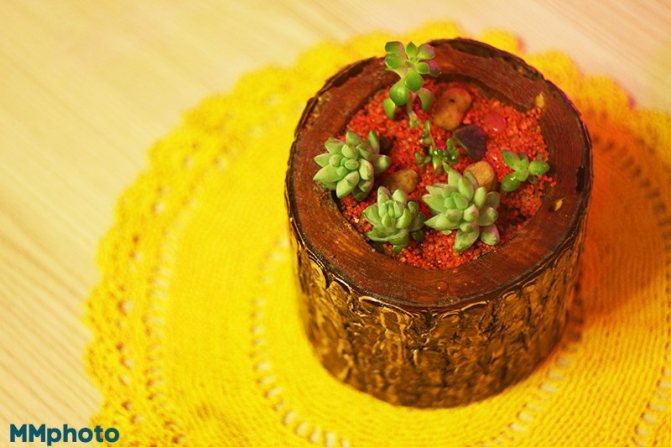

Florariums: Recently, it has become very popular to plant succulents and cacti in florariums. Now you can easily purchase a variety of geometric containers in online stores, and even florariums with ready-made compositions. Succulents grow well in florariums, this is due to the plant's protection from drafts and temperature changes. Read a master class on filling florariums
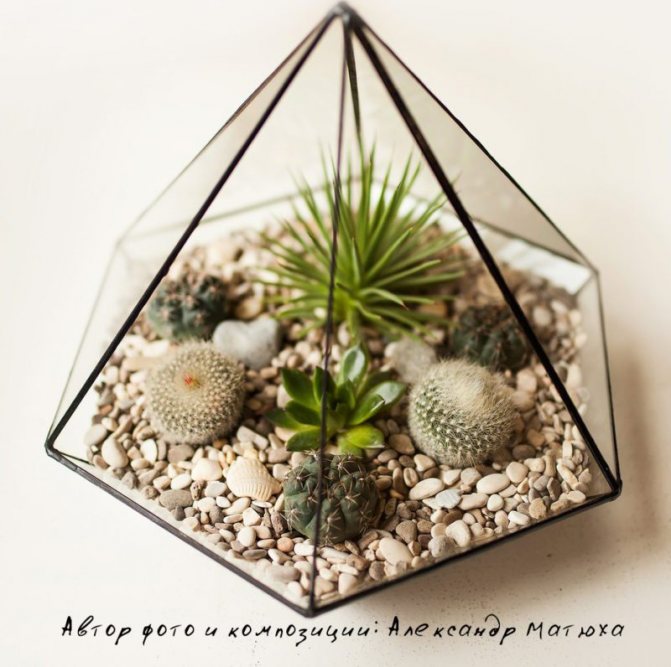

Ball-shaped cacti for a garden in a bowl
Among the spherical cacti, a special group is made up of "naked" cacti, the stems of which are smooth, with little or no thorns.
Astrophytum (Astrophytum) - with a single stem, bearing from 5 to 8 massive ribs. Highly decorative, with dark and light spots and fine villi. The flowers are yellow "chamomile-astrochki" appear in summer several or singly at the top. Astrophytums grow slowly, over five years, up to 5-7 centimeters in diameter. They are quite whimsical in leaving.
Interesting Parodies (Parodia) and Notocactus (Notocactus) - spherical, ribbed, the ribs are divided into tubercles with protruding woolly areoles. The flowers are funnel-shaped, yellow and red, the duration of flowering and the size of the flowers differ in different species.
Video interview about mini-kindergartens and their care
There is also a more economical option - to find a suitable glass vessel at home and fill it to your liking and desire.
What plants can be used
Composition center should be either in the center or on the edge. For the center, tree-like succulent species are used. Can be used:
- Aeonium arboretum;
- Dorstenia;
- Sedum dendrodium tree (Sedum dendrodium);
- Pedilanthus titimaloides (variety - low) (Pedilanthus tithymaloides v. Nanus);
- Adenia spinosa (prickly) (Adenia spinosa).
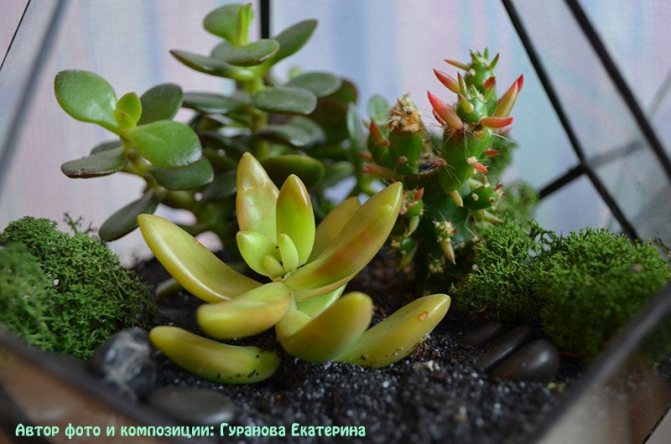

Then you need to place two or three large succulents or cactus... Of succulents, some types of aeoniums (tiered, layered) look very beautiful, dinteranthus microspermus is a plant that looks like gray stones, blooms with a yellow flower. You can also plant the most hardy cacti:
- Mammillaria (Mammillaria);
- Echinopsis (Echinopsis);
- Rebutia aureiflora rubriflora;
- Chamaecereus silvestry.
Desirable, and even leave space in the foreground for small plants, especially if, as they grow, they will hang in small vines along the edge of the container. The more varieties there are, the more interesting the composition will become. Here you can place some of the plants, such as:
- Weinberg's sedum (Sedum weinbergii);
- Sedum sieboldii;
- Other types of stonecrop (Sedum).
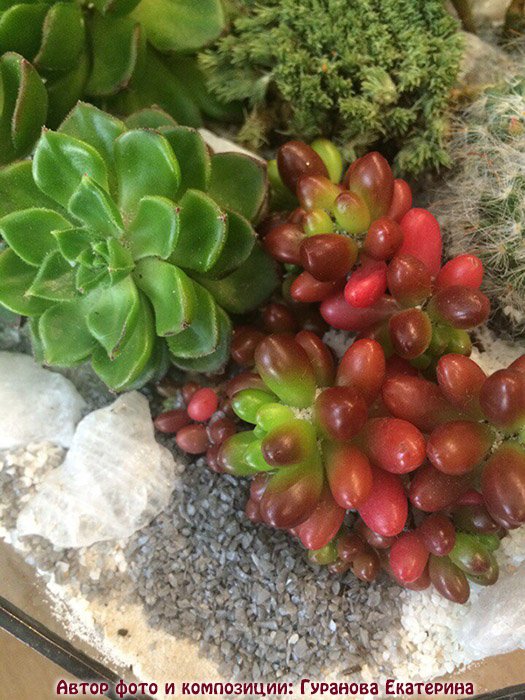

Root bath for cactus
A special healing method (or root bath) for cacti with a damaged root system, used during transplantation. I once read about this method in an old book about cacti, applied it myself and had positive results (with the exception of epiphyllums and Decembrists). It so happens that the cactus is apparently healthy, but grows very poorly, and the roots during transplantation turn out to be poorly developed and weak. Then you can try the following procedure. The cactus, after being removed from the pot, is shaken off the old soil, you can even rinse the roots in warm water, but carefully so that there are no breaks. Then hot water is poured into a cup or glass, at a temperature of about 50-55 ° C. To do this, you need a thermometer.
A dense matter is taken, which is fixed on a glass above the water. A hole is made in the middle and a cactus is placed there, while the roots up to the root collar should be in hot water, but neither the stem nor the root collar should touch the water. In this hot water, the cactus is kept for up to 15 minutes. It is important that the water does not cool down, but remains at the same temperature all the time, you can wrap the glass with a woolen shawl, or add hot water, monitoring the temperature with a thermometer, but in no case cover the glass with the cactus. This procedure stimulates root formation in cacti. After that, the roots of the cactus must be dried for 12-24 hours, and then planted according to all the rules.
Correct planting of plant compositions - step by step instructions
For proper planting, you need to purchase special tools: bamboo tweezers, small shovels, an artist's trowel is perfect, even a teaspoon is useful for filling small containers with soil.
- We prepare the ground or the components of the substrate. We took part of the already prepared land for cacti and succulents, drainage, sand and charcoal. All components were purchased from the store. If you are taking materials from the street, be sure to heat the sand and stones in the oven, or fire them in a skillet.
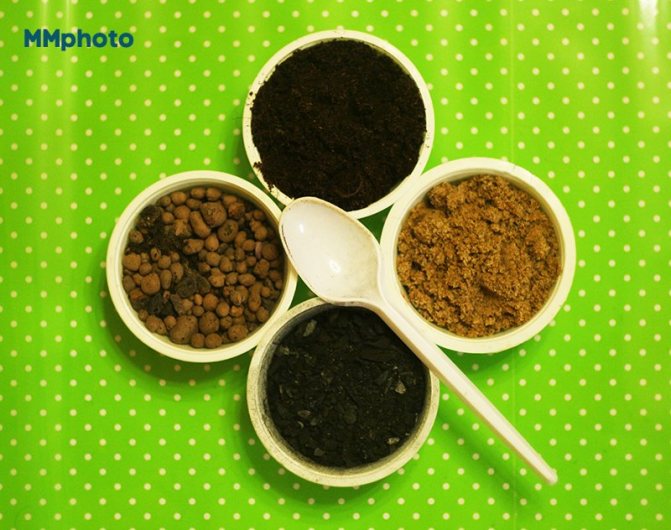

- Choosing a container for planting and plants.


- Fill the prepared vessel (aquarium, glass vase, ceramic flat pot or deep dish) with drainage at least ¼ of the height. In transparent containers, you can separate it with a layer of colored sand.
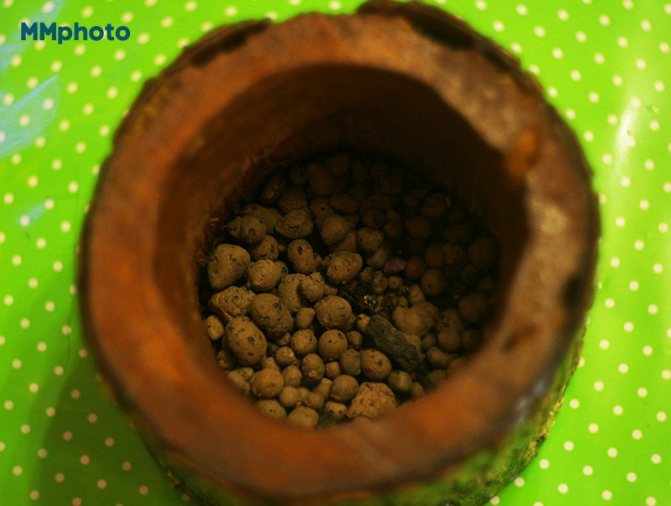

- Next, carefully pour in the mixed potting mix. Leaving 1 cm from the top of the pot, and make depressions in the soil, marking the planting sites.


- Carefully straighten the roots of the plants (for cacti, they must be carefully examined and cut out old and rotten or dried roots). Please note that the root collar of the plant is not covered. This is important, if you deepen the neck, then moisture accumulation and decay may occur.


- We transfer all the plants, making up the composition. We plant ampel succulents along the edges.
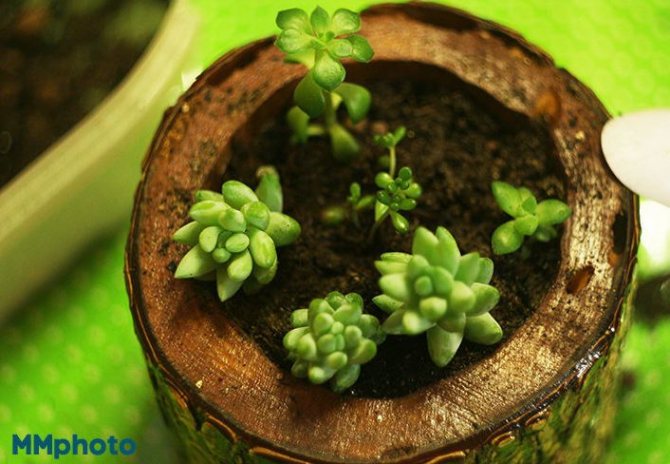

- We fill the top layer of soil with sand. And then decorate with coarse colored sand or small pebbles. You can take shells or pebbles.


- In the end, you can decorate the bare areas with colored pebbles, artificial moss, shells and put decorative elements. You can buy small ceramic gnomes, and if the composition is being prepared for a New Year's gift, then put the figures of Santa Claus and Snow Maiden.
Soil for cacti
First, once again about the soil for cacti. It should be loose, water and air permeable. One of the main loosening components of any substrates is sand. But we often omit the postscript, taking it for granted that the sand should be river sand, well washed, and sifted from dust. If this is not done, then the sand will not add loosening, but cementing properties to the entire soil. Take a look, there are two types of sand in the photo, one is taken in a sandbox near the house (it got there from a construction site), the second is river sand, washed and larger (sifted), they even differ in color. After wetting, the first sticks together in lumps, the second, on the contrary, does not keep its shape - it crumbles, and, of course, only this is suitable for us.
Another component is zeolite granules made from cat litter filler (Barsik-standard or any other, only non-clumping filler). They are also added for loosening, but for this they are prepared: they are thoroughly washed and then sieved. A coarse fraction is added to the soil. The remaining components of the substrate, traditionally: garden soil or universal soil from the store and small expanded clay. The earth can be replaced with a coconut substrate, which has the main advantage - friability, it does not stick together into a monolithic piece, allows the roots to breathe, and its acidity is close to neutral. When adding coconut substrate from briquettes, it must be borne in mind that it swells when it first gets wet, increasing in volume three times. In order not to be mistaken with the quantity, and after the first watering the cacti did not "kicked out" from the pot, it is better to wet the coconut substrate in advance and dry it again, and then mix it into the soil.
Photo ideas for making gardens from succulents
If you still have questions, you can ask them in the comments to the article! Thank you for reading us, success in your creative floriculture business!
Every year, succulent compositions are gaining more and more popularity in design. These unpretentious exotic plants will suit everyone who wants to decorate the interior in a lively and original way. Due to their unpretentious care, beautiful shapes and a wide range of colors, succulents have become an indispensable decorative element for designers.
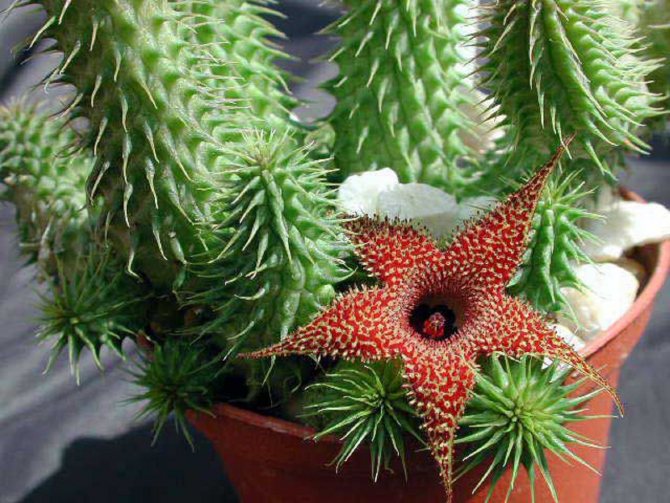

Use decorative powder
It is not only beautiful but also beneficial to the plants. Since the composition of succulents and cacti is located in a small container, moisture evaporates faster, the roots may become bare. Powder with fine stone chips, glass decorative elements, fine expanded clay, etc. will slow down these processes and protect the root system from overheating. The latter is likely due to the fact that such mini-gardens require direct sunlight, only in this way they will retain maximum decorativeness and not stretch out, not fade.
The role of succulents in design decisions
A rare design does without living elements - plants. Unfortunately, flowers are difficult to care for. Often, due to the lack of light, insufficient watering or improper temperature conditions, indoor plants die, and without them the decor becomes defective.
Interior decoration with succulents, due to their unpretentious care, opened up new horizons for designers. These plants are multifaceted, differing not only in the size and shape of the leaves, but also in color and texture. In addition, there are flowering species that make the decor look fresh.
There are many ways to use succulents in your home. The most common ones are:
- Phyto paintings from succulents. Plants are planted in the ground, which is placed in a deep frame, and hung on the wall. Such a composition is watered from a spray bottle without difficulty.
- An alternative to phyto painting is a panel made of artificial (dried) succulents... It is arranged in narrow frames and does not need maintenance, and due to the properties of this type of plant, it will delight the eyes of the owners for a long time.
- Arrangements of succulents in pots... Interior decoration doesn't have to be flashy. Plants are also pleasing to the eye in simple pots, the main thing is to correctly compose the composition and choose a suitable place in the house.
To make succulents in the interior look beautiful and delight the owners, you need to follow the rules for decorating and caring for plants.
Preparatory stage
Before starting the organization of the florarium, it is necessary to do the following - prepare a container, soil, pick up plants, study the basics of the composition and think over how the "inhabitants" of the florarium will be located inside the transparent container.
Choosing a location for the florarium
Florarium of any type - sealed or open - should not be placed close to the window, since the sun's rays will refract through the glass and can provoke leaf burns. Accordingly, choose places that are darkened, where direct rays do not fall during the day. Only in winter, when there is not enough sunlight, can the container be moved to the windowsill.
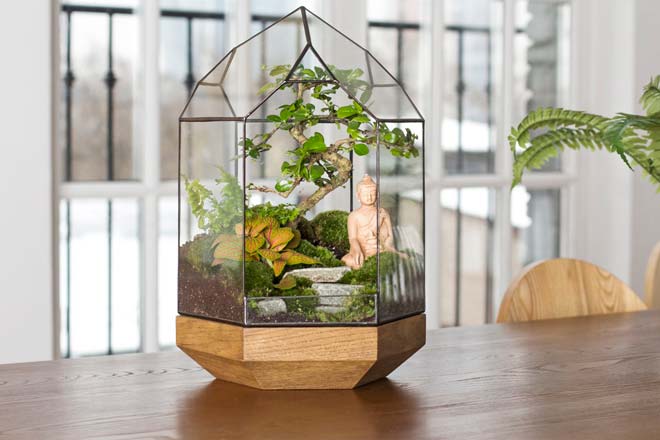

If you have chosen light-loving plants, arrange artificial lighting. In addition to the fact that it will create a good microclimate for the inhabitants of the florarium, the decorativeness of the composition will improve. When watering, try not to wet the glass, as drips inside the container will worsen the degree of light penetration and decorativeness. The same rule applies to condensation - ventilate a tightly closed vessel regularly so that drops of moisture and mold do not appear on the inner surface of the glass.
The florarium can be organized not only in a dry container, but also in water. The miniature pond looks original, but it requires more maintenance, since with high humidity, flowering immediately begins.
Tank and soil preparation
The following vessels can be used as a container for a home greenhouse:
- flask;
- decanter;
- round glass ball with a hole at the top;
- candy bowl;
- large light bulbs;
- glasses;
- glasses;
- ordinary and decorative cans;
- aquariums with and without a lid.
For growing succulents, a sand-gravel or gravel crop is suitable. Gravel and sand can be collected by the sea or purchased ready-made mixes at the store. Before planting plants, treatment is required from bacteria and fungi. It is optimal to ignite the mixture on a baking sheet or in a frying pan, after having washed it under running water.
Interior design ideas
The variety of succulents often dazzles the eyes, and good ideas do not form into one perfect one. To understand what kind of plants will take place in the future interior of your dreams, it will not be ashamed to spy on the projects of designers on the Internet, take into account all the pros and cons of each of them.
One of the easiest ways to make your little home garden unique is with pot mixes. By combining small vessels, you can create whole compositions, and it is more convenient to care for plants planted one by one.
It is not difficult to make a picture of succulents with your own hands. The avant-garde nature of such a decor item scares some novice designers, but in practice the process does not take more than a few hours, and the result will delight the eye for many years.
Mini potted garden
One of the simplest ways to design succulents is to plant them in one large pot. So that such a composition does not look too ordinary, you have to get out.
Succulent mini-gardens are becoming more popular every year.How do they differ from ordinary plants planted in the soil? In addition to the many varieties of succulents, special decorative elements from specialized stores are used for decoration. As a result, the planted flowers resemble a small corner of nature on a shelf. Due to the specificity of the succulent family, they are often used to create indoor "rock gardens".
The right dishes
One of the main advantages of the selected plants is a small root system and a low growth rate. This allows you to create spectacular small do-it-yourself succulent compositions that will not take up too much room space. Wide and low bowls, which can be in several tiers, with decorative elements, are best suited for these purposes. In terms of color, preference should be given to neutral shades that will not visually distract from the plants, but only emphasize the bright greenery. Remember one rule: the height of the bowl should be about 1/3 of the entire composition. The material of the dishes can be anything: plastic, ceramics, glass and even wood, but always with a drainage layer and holes at the bottom to drain excess moisture when watering.
How to create a composition with your own hands
In order for a corner of succulents to appear in an apartment, it is not necessary to call a designer or florist. You can settle these unpretentious plants in a pot with your own hands. You can decorate and transform a composition of cacti and succulents as your heart desires, even without special tools at hand.
Basic layout principles
There are no restrictions in the design of the future living area, except for those dictated by the general style of the apartment and the taste of the creator, but you should be careful with the selection of plants. There are a number of helpful tips to keep in mind before starting the creative process:
- If you want to create a unique composition, it is best to use a rectangular, white painted vessel. In such a container, all attention will be paid to the succulents and decorations inside the pot, and not to himself.
- When working with vertical compositions, the main thing is to cover the root collar with soil. From above, you can lay and even glue stones, decor and pieces of brick - this will not harm the plant.
- If the decision was made to plant succulents in a glass vase, you must definitely take care of how the moisture will evaporate. If the bud is too wet, the root system will quickly rot and the plants will die.
- Living pictures of succulents are best kept for the first time (at least 2-3 months) in a horizontal position, so that the plants get stronger and get used to the new environment. Only then can the resulting decor element be turned over and hung.
It's not a shame to look at the ideas of compositions on the Internet. In any case, it is impossible to repeat such a work, therefore every work with succulents is a work of art.
Which plants are better to use
To create flower arrangements, you can pick up any plants, but it is best to use cacti and succulents. They are in perfect harmony with each other, are picky about care and add a certain amount of exoticism and piquancy to the interior.
In no case should you add various mosses to succulents. They retain moisture on the surface, and it harms the throat of the plant's root system.
Decorative ferns and crotons look good in the composition. Compared to small succulents, they look gigantic, but they add volume to the composition.
Alocasias work well for creating a tropical look. This plant looks like a large water lily on a long stem and, due to its unusual appearance, refreshes any composition.
What can be planted with what
Despite the fact that succulents do not require anxious care, only compatible subspecies of this family can be planted together. It is imperative to pay attention to the following factors:
- Plants must grow in similar climatic conditions. You can not plant moisture-loving succulents with cacti in the same pot, which cannot tolerate abundant watering.
- Do not plant large plants with miniature ones. The root system of large succulents will simply suffocate the roots of small ones, and they will quickly die.
- Do not plant close flowering and non-flowering plants. The former require much more nutrients during flowering, and because of this, succulents without flowers may simply not be enough.
The choice of capacity and substrate
Anything can serve as a pot for a future composition - from a fancy-shaped wooden box to a pots specially prepared for succulents. The main thing is to remember that there must be holes in the bottom of the vessel for excess moisture.
The most popular containers for succulents at the moment are:
- Florariums or small aquariums, glass vases.
- Deep frames for wall compositions.
- Cache-pot.
- Loft style pots made from old boxes, wooden boxes and more.
How to plant plants
You need to plant succulents for design in the same way as in ordinary pots on the windowsill, but taking into account the characteristics of the place and vessel.
If you decide to plant flower arrangements in a cup or other unusual vessel without holes in the bottom, you need to make them yourself, or choose a more moisture-loving subspecies of succulents for planting.
When working with vertical compositions, the main thing is to allow the plant to take root, to strengthen its roots in the ground. From above, the soil must be pressed down and strengthened. Stones are best suited for this. They can be glued to the sides of the vessel and to each other for strength.
No matter how good the succulent compositions are, beautiful plants are only healthy plants. When creating your own decor element, you need to take care that, if necessary, the succulent can be transplanted, fertilized or treated with a parasite remedy.
If the future composition will be in dark places of the apartment, you need to pick up special plants for it. Leaving succulents without light can quickly destroy them. At the same time, some subspecies of this plant can live comfortably in dark corners.
Use of decorative elements
There are many ways to make your composition unique, and using additional decorative elements is one of them. You can make them yourself, buy them in specialized stores, or find suitable household objects.
Sand decoration is the most economical and effective way to create a composition of succulents. Imitation of desert dumps, a rock garden and just drawing are just a few of the possible options. Sand opens up a huge scope for creativity.
Florists, aquarists and creative outlets sell a variety of miniature items that can be used to create compositions. Small houses, trees, animals and even little people will help make a real work of art out of a simple pot of flowers.
Subtleties of care
Caring for succulents in a decor is no more difficult than for plants in a pot. You just need to take into account those special conditions that you have created, for example:
- Plant only in suitable, prepared soil.
- Let the plant take root, strengthen the root system.
- Water regularly.
- Treat against parasites.
In order to create your own composition of succulents, you do not need a step-by-step recipe. The creative process does not tolerate restrictions, and working with this type of plant contributes to the lack of a framework. The only thing to be reckoned with is the biological limitations of the succulents themselves, which are extremely undemanding. The rest of the designer is limited only by his imagination.
Timely care is half the battle
After the selected plants are planted in the right order, the question arises of how to preserve this unique mini-garden.In fact, there is nothing complicated, and the leaving process consists of several main points. First, the removal of excess growth, which begins to interfere with neighboring plants and spoil the decorative effect. If the composition of succulents is made correctly, then the need for a transplant will not arise for at least 2 years. Secondly, watering. It should be regular (in the case of cacti, do not forget the dormant period in winter) and neat. Direct the stream of water towards the largest leaves or stones so that it gradually reaches the soil surface. You can use a drip system. To drain excess moisture, there must be drainage holes and a pan.
Succulents for an alpine slide
Your garden, for example, in the Moscow region can be improved by arranging a man-made rock garden. This action is bold, every flower lover is able to be original on his site. For this purpose, street succulents are used. A well-lit area of the garden can serve as an ideal place. The background will be the facade of the building.
Cyclamen forest and other street types: garden, kosky, mix
However, before proceeding with the design, starting the design of the garden, it does not hurt to work with special literature, enrich the knowledge about the plant world.
Succulents in the garden: planting and care
Unusually beautiful and unpretentious in care - this is how succulents are characterized. In any region: in Siberia, the Urals and the western regions, the requirements are the same. They need plenty of light, a convenient container or pot to grow, and minimal care from a grower.
Housing design, public institutions benefit from the cultivation of unpretentious flower stalks.
Succulents outdoors: how they winter
Wintering of succulents in temperate regions has become possible thanks to the passion, resourcefulness of gardeners and florists. It was through the efforts of enthusiasts that cacti and other southern representatives of the plant world came out into the open ground. Even wintering succulents have appeared for the garden, agrotechnical methods have been developed for their cultivation in open space.
What soil to plant
Oddly enough it sounds, but it is necessary to grow succulents in open ground in loose, poor, clayey and even stony soil. Such conditions allow moisture and air to penetrate freely to the roots. With regard to clay soil, there is a judgment among experts that this mineral substrate meets the basic requirements:
- inertia;
- chemical neutrality;
- ability to retain water;
- aeration;
- strength.
Note! River sand, fine gravel, activated, but not medical coal, can be used as soil loosening agents.
It is not worth overfeeding succulents, because of this they bloom less often, the color of the flowers fades, the needles do not develop enough, the plants lose their survival during the wintering period.
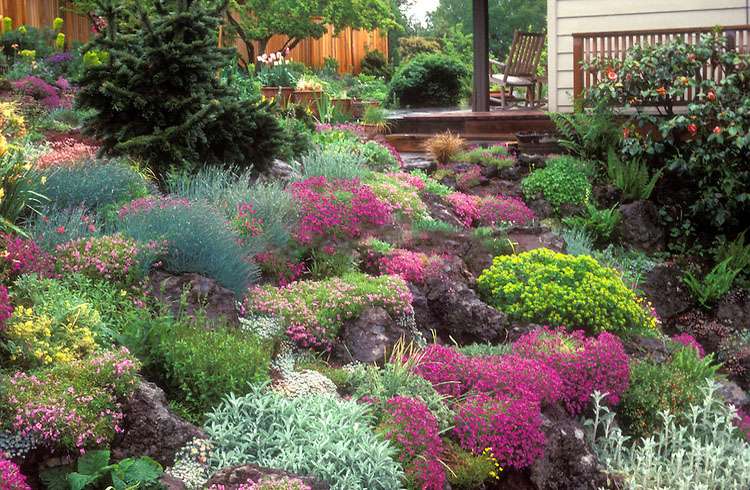

Alpine slide in the yard
Fertilizer
Florists should not often water, feed with black soil and heat succulents in winter. Winter is the time when it is better to leave the plants alone, not to fertilize. An excess of fertilizer provokes the growth of multiple thinned, weak shoots.
In the spring, feeding is carried out no more than 1 time per month with low concentration fertilizers. Specialty mineral supplements are available at flower shops.
Combination with other materials
Succulents and cacti go well with all natural materials. Pine and spruce cones, clay, tow, pebbles, moss, needles, wood:
If you choose a house made of natural materials for the mini-garden, you can get real fabulous decorations:
The toys in the mini-kindergarten, of course, do not have to be natural colors. But to me personally, new toys, especially bright colors, seem a little poppy:
Although, as you know, only the Sith are elevated to the absolute. There are no dogmas and rules in design for all occasions.If you like bright colors, and natural materials seem boring to you, there are absolutely no contraindications to combining bright toys with succulents and cacti. At the same time, if you pick up a cactus blooming with a bright flower, as well as a couple of small variegated plants, you will get a bright and cheerful mini-garden.
Species and suitable plants
The florarium can be open or closed. Indoor is ideal for plants that like high humidity. It can be:
- Fittonia.
- Orchids (e.g. Phalaenopsis)
- Some varieties of begonias.
- Predatory plants (sundew, flycatcher).
- Bromeliads.
- Small Saintpaulias.
- Fern pellei.
Photo gallery: flowers for a closed florarium
Succulents are best suited for an open florarium:
- Aloe.
- Fat women.
- Sedum.
- Cacti.
- Echeveria.
- Agave.
Photo gallery: specimens for an open mini-garden
So, you will need:
- air-dried clay;
- a small cactus in a small seedling pot;
- clay roller;
- cookie form;
- cutter for linocut (wood carving);
- two wooden planks 0.5 mm thick;
- plastic bag;
- ruler;
- household knife.
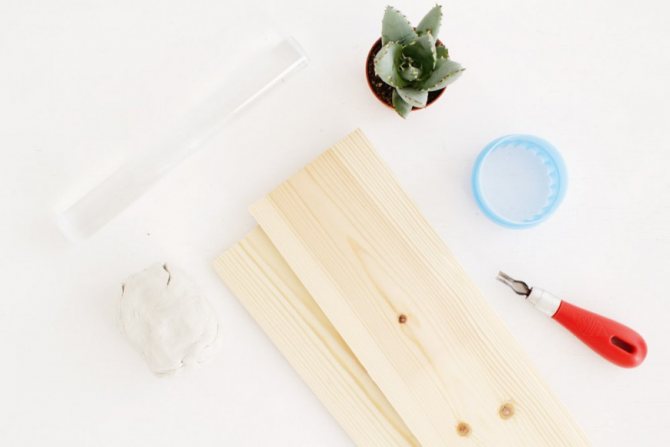

Plants for the garden in a bottle: how to choose the right one?
For keeping in a glass container, it is better to choose slow-growing plants, otherwise the composition will have to be updated very often. Usually, plants slow down their own growth, since the root system simply has nowhere to develop in such a small space. In some cases, it is appropriate to slightly prune the roots during transplanting in order to slow down their growth.
When choosing plants for the florarium, you need to consider how they get along with each other. It is advisable to choose such options in which a certain natural area behind the glass is recreated:
- To create a desert with your own hands, all kinds of succulents (cacti, aloe, euphorbia, fat woman, etc.) are suitable. By the way, a florarium with cacti is practically the easiest and most classic option.
- Ferns and moss can give the effect of a dense forest.
- You can decorate your own tropics using orchids, dieffenbachia, bromeliads, alocasia, etc. (by the way, when using flowers for the florarium, the main thing is not to overdo it: 1-2 flowering plants are enough). It is the do-it-yourself florarium with orchids that has recently been at the peak of popularity among flower growers. Tradescantia in a bottle is also common.
- The mountain landscape will be recreated by succulents with various ivy.
Advice! If the plants are nevertheless selected for their beauty, and not for the same needs, the following trick can be applied: plant them in different pots or containers and cover the surface with stones. It will be possible to take care of each of them individually, and from the outside it will seem that the whole composition is in the same soil.
Consider the step-by-step instructions for composing a composition from cacti:
1. We collect all our cacti and succulents, free them from old pots and soil, look through all the roots and the body of the cactus itself. If there are rotten spots, carefully trim or remove them.
Separately, we make a solution of potassium permanganate and water to disinfect our thorny plants. To do this, dissolve several crystals of potassium permanganate in warm water (35–40 ° C), and place our thorny plants in our solution for a while. After 15–20 minutes we take out our handsome men, put them on the newspaper and let them dry. 2. Prepare the container for our composition. For most species, a shallow wide pot is suitable, in this case we use a bowl. At the bottom of the bowl we put expanded clay for our drainage. The drainage should be 3-4 centimeters high. Add a little earth on top and make recesses for planting our plants, having thought out the appearance of the composition in advance. Do not forget to combine cacti and succulents with the same lighting and care needs.
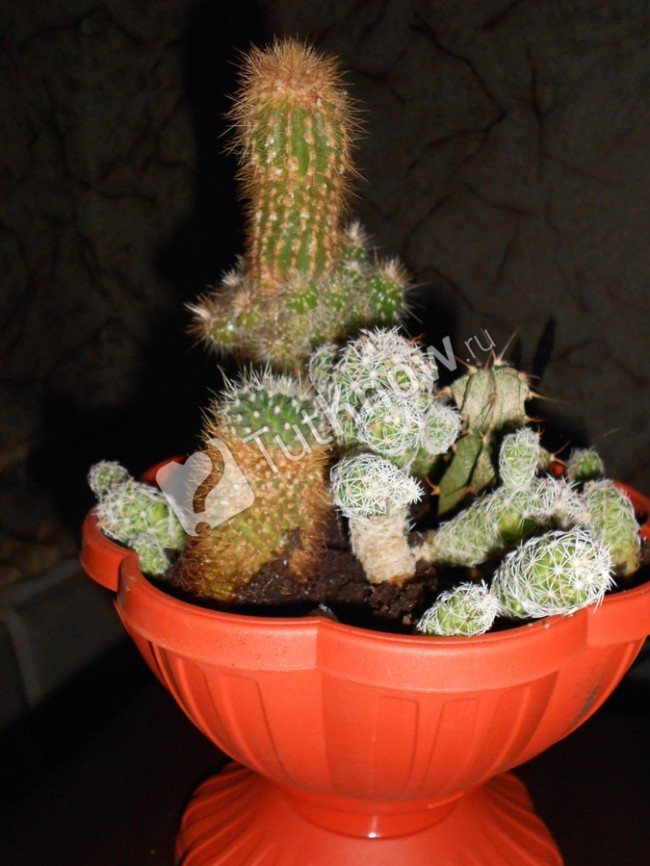

3. Planting cacti and succulents.There are two ways to plant plants: each cactus in a separate pot, using a bowl as a planter, or planting directly directly into the ground. This choice is up to you.
If the planting takes place in separate pots in a bowl, then we expose our pots with already planted cacti according to the conceived plan, and sprinkle the container with earth between the pots, and on top you can use different stones, shells or colored glass.
Landing directly into the ground occurs in a slightly different way. Our "thorns" and succulents are planted in the previously prepared holes for the plants, sprinkled with earth on top and tamped lightly with your fingers. On top of the earth, if desired, sprinkle with stones, shells or polished glass.
4. The final stage is watering and lighting the compositions after planting. After planting, transplanting or transshipment, cacti are not watered or exposed to a sunny place. Place your composition in partial shade for a few days. Then, instead of watering, you can spray with small drops so that there are not drops, but water dust. And in a week you can put it in a sunny place.
Such compositions of cacti and succulents will pleasantly delight your eye not only on the window sill, but also in any illuminated place in your room.
Cactus bottles
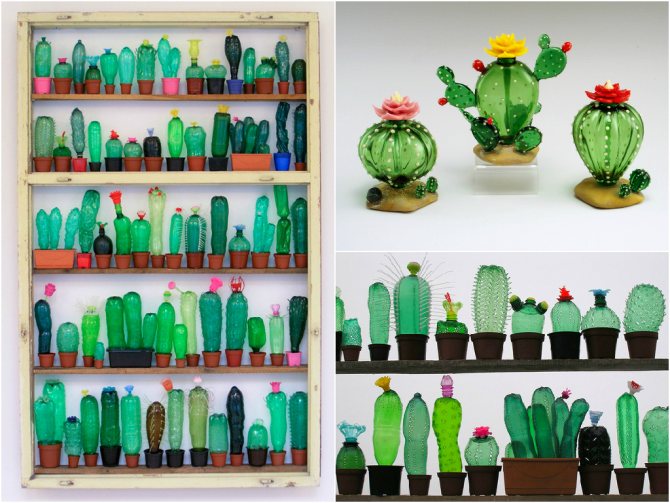

Last but not least, who said your cactus should be alive? Made from recycled bottles that have been transformed into different types of cactus, this rack is a fun project for kids. Inverted bottles in flower pots, with the addition of thorns, create an impromptu garden right in your home.
Regardless of what types of cacti you will give - they will certainly delight the recipient! The main thing in any surprise is emotions and mood, so please your loved ones with gifts, and of course flowers from the company!
Vases and figurines
Do you think a bouquet of roses would look odd in a cactus-shaped vase? It seems to us that the combination of the incongruous can look very stylish.
Absolutely crazy art object in the form of a huge cactus (meter seventy in height) designed by Drocco & Mello and costs £ 3,835. It is available in red and black.
The same cactus with eggs (look at the photo and you will understand that this is its official name) costs twice as much - £ 6,160.
Are you running out of space on your windowsill? Are there a lot of sand plants scattered all over the windows and they have no aesthetic appearance? There is a way out - make compositions from the cactus family. Collect several species in one bowl, and you will see how their appearance will change. From the many separately growing, you will get several beautiful compositions of cacti and succulents.
Cacti, sharp scissors or pruning shears, earth, drainage, a bowl, potassium permanganate, water and fantasy are all you need when composing a composition.
Plant care
In order for the florarium to please the eye, it needs, though minimal, but care. What care measures need to be taken depends on the plants that are planted in it.
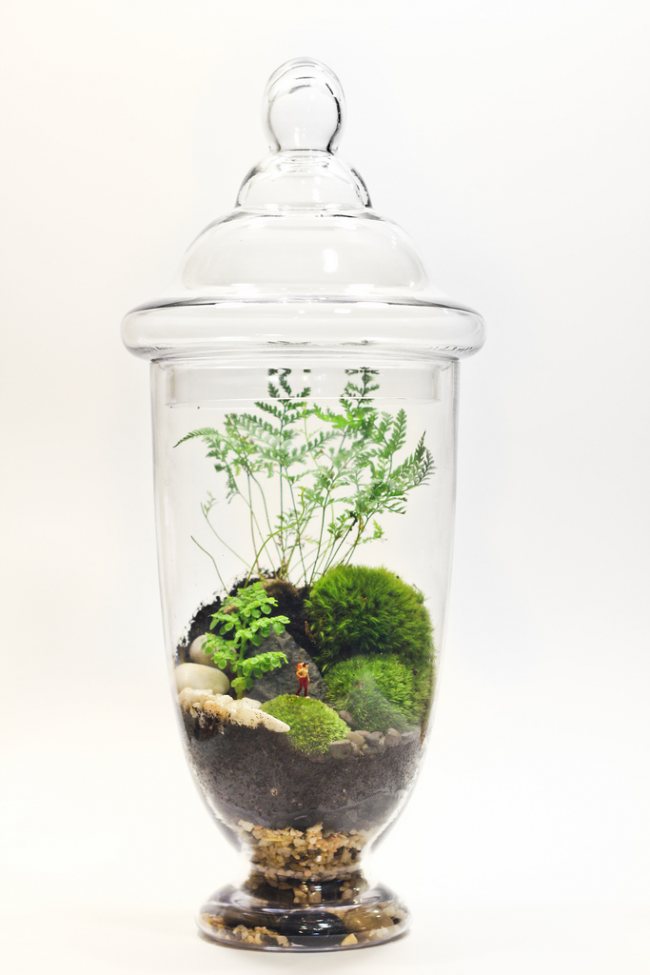

A small florarium with your own hands with a composition of mountainous terrain
Features of reproduction and transplantation of succulents
Let's start with the first one - the tops of branches (cuttings) or fleshy leaves are used as planting material. It is not necessary to send the cuttings to a container of water - let the cuttings dry slightly (1-2 days), and then just stick them into the damp ground.
As for the leaves - it is necessary to act differently - at first they completely separate them from the stem, so that organic residues are not observed on the cuttings. After that, they simply put the leaf on moistened, loose soil in a well-lit place. The succulent leaf itself will start up the roots and anchor in the ground - there is no need to bury it in the ground.
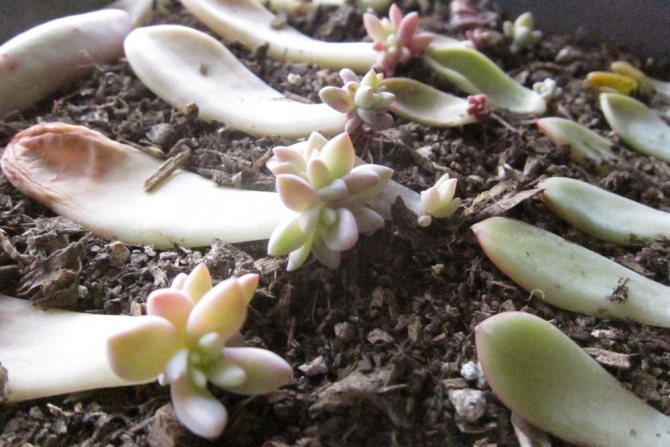

Succulents give an abundant number of shoots: feel free to separate the babies from the mother plant and plant them on wet ground.In such conditions, they take root on their own.
The period allotted for the manipulation of the transplantation (reproduction) of plants in the conditions of our latitudes falls on April - August (the most favorable months are April and May), when solar activity is high. Nevertheless, stonecrops willingly take root in the fall - the faded stems are cut to the ground and stuck into damp ground. In the spring, most of them germinate and produce new individuals.
Furniture
Buying themed furniture is a big step. And only a person with a sense of humor, who is not afraid, can afford furniture in the form of cacti. The chair by Mexican designer Valentina Glez Wohlers is famous for combining a traditional French shape and an extraordinary back with one of the symbols of Mexico - the cactus. Such a chair can be made to order by writing to the designer.
The headboard also allows you to experiment. Once we have already shown you, here is another bright and cheerful - Watercolor Cactus.
Don't like banal things? Then the cactus-shaped hanger will definitely suit your taste. Surprisingly, it comes in five different colors.
There seems to be no better place for natural prints than the terrace of a country house. When we saw these relaxed chairs with a bright base, we thought: "What you need!".
How to plant succulents
Such mini-gardens of cacti and succulents with houses and paths are sold ready-made. But, in my opinion, it is much more interesting to do it yourself:
Photo by Marina Gerchet
Dishes and pots
Is it difficult to make a mini-garden of succulents and cacti? Not a momentary affair, but not so difficult either.
Any dish is suitable: low pot, large saucer, container, candy or cookie packaging. People use everything, down to glasses. The choice of cookware depends on what structure you give your creation and where you put it.
Craftsmen make mini-gardens from succulents even in such jars, using tweezers and tablespoons for planting:
If there are several varieties of cacti in the house, and they are all planted in different pots, then it's time to plant them together. Cactus gardens look very impressive, easy to make, easy to care for. How to make them and what is needed for this, read below.
Size matters: determine the size of the composition
First of all, you need to decide on the size of the composition: it will be a simple small cactus or garden in a cup, glass, bowl, or a large composition in an aquarium, bowl, large wide flowerpot. See if there is enough space on the windowsill or shelf, near the window, for a future masterpiece. Take into account the illumination - it should be sufficient, not scarce. In small pots, accordingly, it is necessary to plant cacti that do not grow quickly or do not grow large.
Mini garden in aquarium Mini garden of cactus in a cup
Selection of cacti
Before proceeding with the grouping of thorny plants, you need to find out if they fit together, or if their cohabitation is undesirable. For example, Cereus grows quickly and grows large - it is not suitable for small mini-gardens. And mammillaria and echinocactus do not like temperatures below +15, therefore, it is better not to combine them with cold-resistant cacti. In more detail, the features and preferences of the most common types of cacti can be read
Preparing soil for a mini-garden
When the choice is made, you need to take care of the soil mixture for the cacti. There are two ways to go:
1. Buy a ready-made mixture for cacti in the store. Prepare yourself only a drainage layer of gravel, small stones, broken brick or foam (which you can find).
Now all that remains is to prepare decorative trinkets.
Selection of decorative accessories for a mini cactus garden
The most unexpected objects that can fit in size can act as a decor.You can come up with a thematic composition (sea, desert, rural courtyard and others) or simply arrange it according to your wishes and mood. Here are some accessories that can be applied:
- toy household equipment: shovels, rakes, buckets, watering cans;
- stones of different types and sizes;
- marine attributes;
- beads of different sizes;
- sand of different colors;
- small figures of animals, insects, men, gnomes.
And much more, because human fantasy has no boundaries.
Making an indoor cactus garden
Planting a cactus garden is as follows:
- Pour a drainage layer on the bottom of the pot, not forgetting to make holes in the pot itself.
- Pour a small amount of soil mixture into a pot.
- Place cacti in a pot for guidance and adjustments.
- Choose the most suitable accommodation option.
- Plant one at a time, cacti in a flowerpot.
- Cover with soil mixture, and put pebbles or sand on top.
- Decorate at your discretion and taste.
- Watering cacti on the day of planting is not worth it.
Well, the composition is ready to be admired and grown on the windowsill.
Having created a mini-garden of cacti with your own hands, you can get a lot of pleasant emotions from the very process of planting and decoration. And the originality and beauty of the composition will delight the eyes for more than one year.
- Indoor mini-gardens: photos, varieties, selection ...
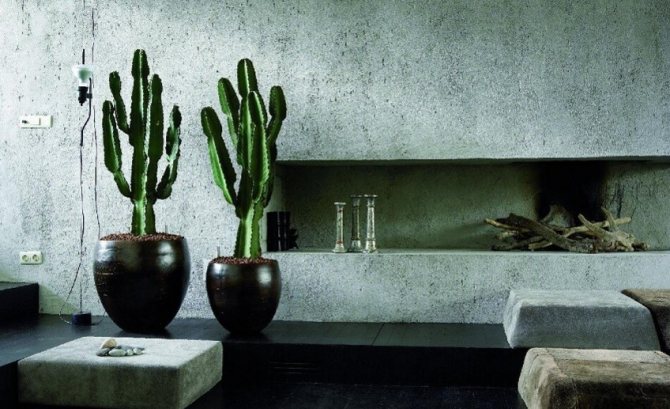

There are plants that
12:00 06 May 2016
There are plants that can beautify our lives without requiring much time and trouble in return. These are cacti - thorny desert dwellers. They are the most unpretentious of all indoor plants, moreover, they are perfect for interior decoration.
The cactus has a very expressive silhouette, so it will be appropriate in almost any room. In a spacious room, for example, a large, overgrown cactus that looks like a tree will look good. It can be placed in a tall clay flowerpot in the very corner of the room, it will give your interior an exotic touch and serve as a symbolic space divider. It is better to place small cacti in a cramped room, they will create a certain atmosphere in the interior and help to visually hide some imperfections. A great solution: combine small cacti into groups and place them on the coffee table, on the shelves of a bookcase, on the steps of the stairs.
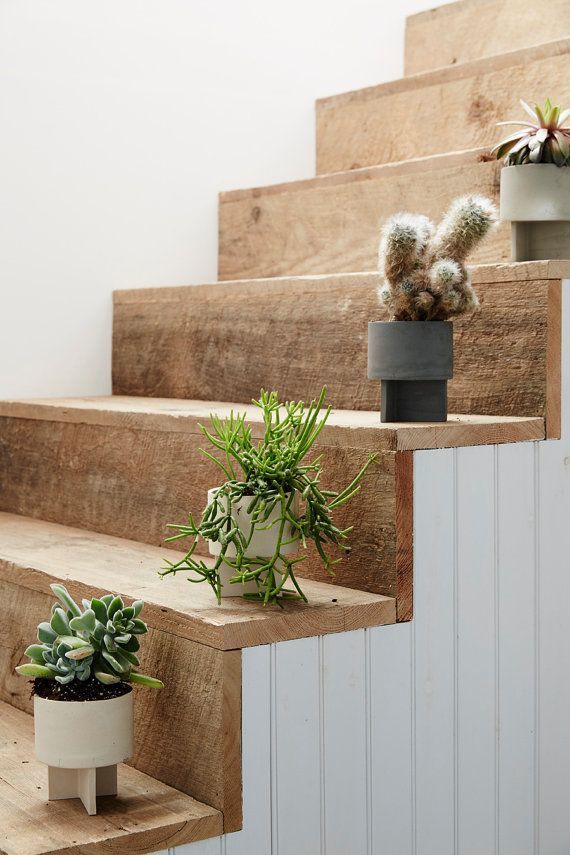

Any glass container can serve as a pot for cacti. For greater decorativeness in a glass pot, the soil can be alternated with light pebbles or with decorative colored stones.
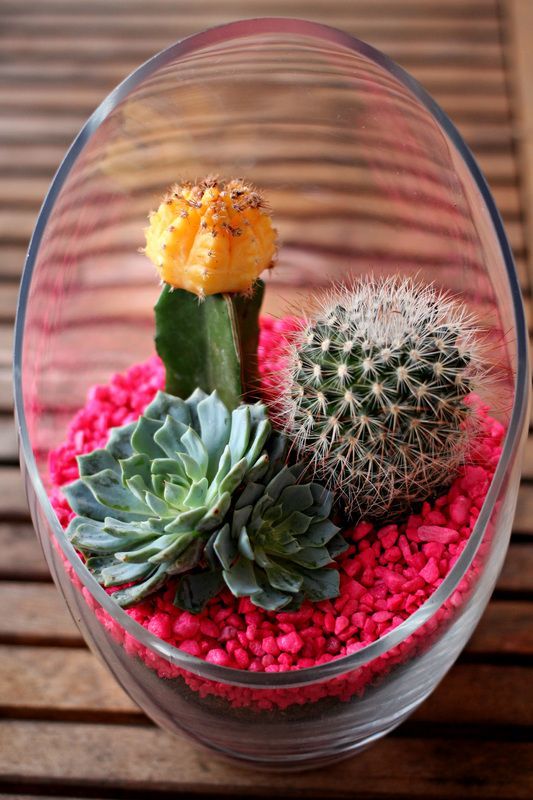

Since cacti do not need a lot of soil, you can abandon standard flower pots in favor of original ones, and sometimes even do without them, replacing them with seemingly completely inappropriate objects for these purposes. Cacti in unusual pots of various colors and shapes will become a bright accent in any interior.
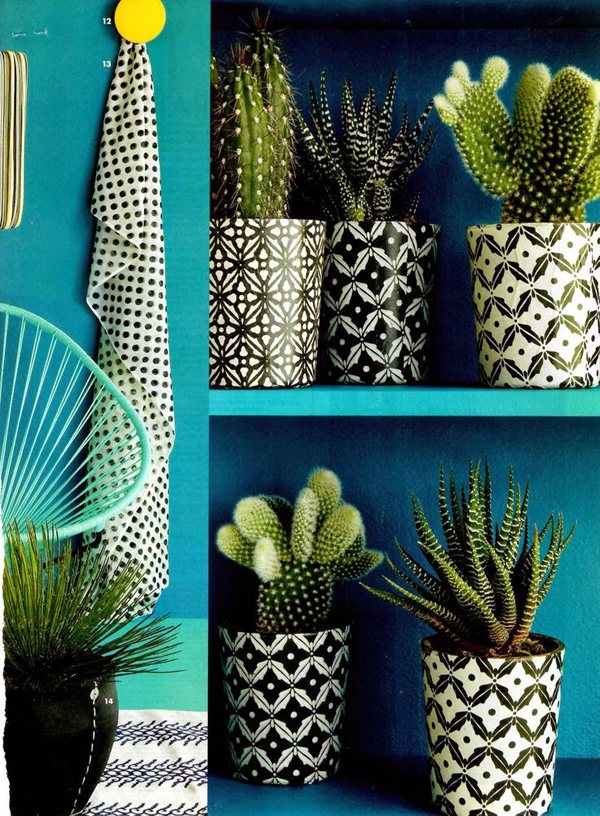

Compositions of several cacti that match in shape or shade look quite impressive. When composing such compositions, taller specimens or cacti with a darker silhouette can be placed in the background. A collection of small mini cacti can be placed in wide flowerpots. Unlike the standard composition, the collection will be able to emphasize the individuality and beauty of each plant.
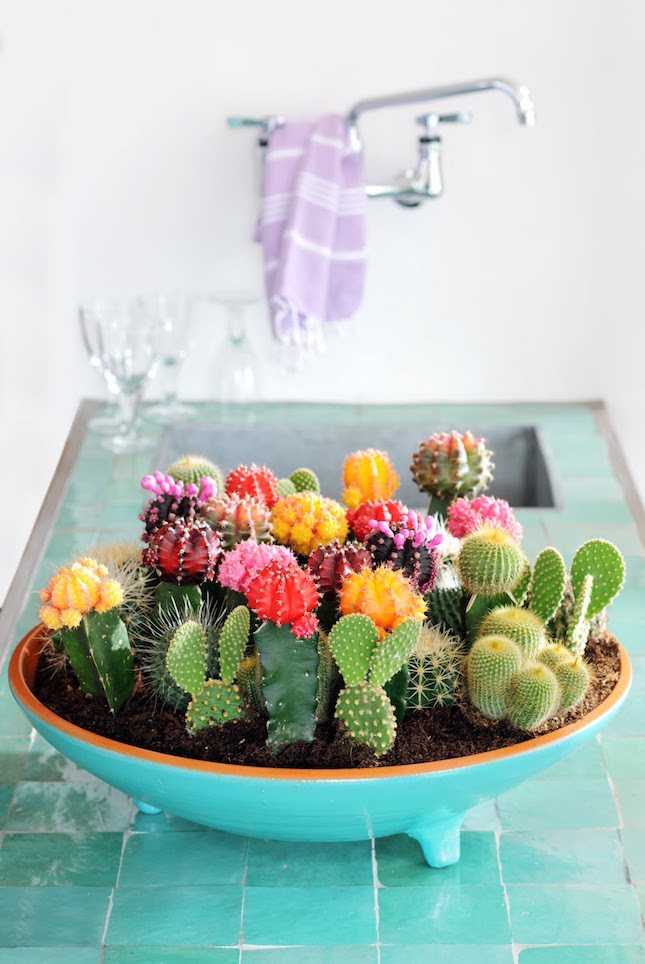

By the way, cacti go well with other indoor plants. Therefore, creating an interior composition of several cacti on a table or on a windowsill, you can supplement it with other plants - without thorns. In this case, of course, it is worth considering their needs and the peculiarities of caring for them.
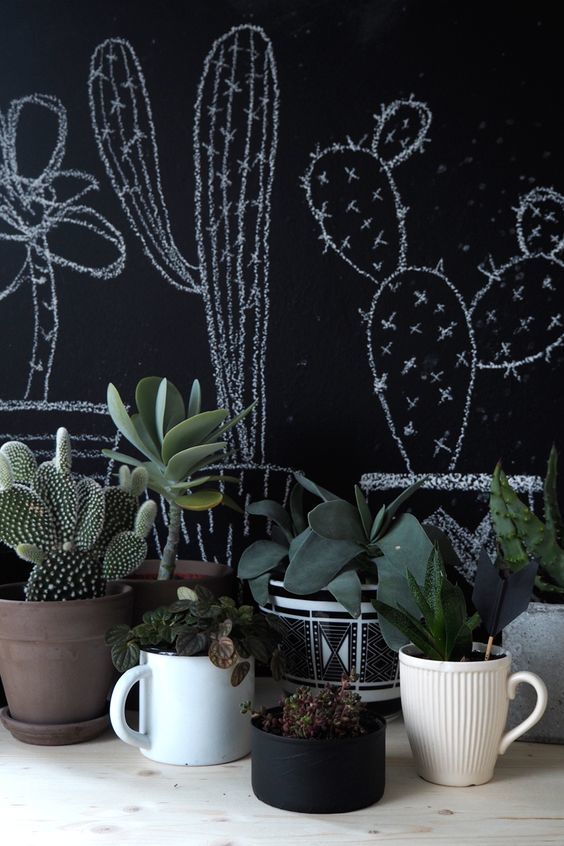

Cacti thrive in mini glass greenhouses, where you can maintain the optimum temperature for them. In addition, in such greenhouses, cacti look very original. Especially if you cover a composition of several small cacti with a glass cover.And if you also make lighting under the glass, then in the evening such a composition will be the center of attention of the entire interior.
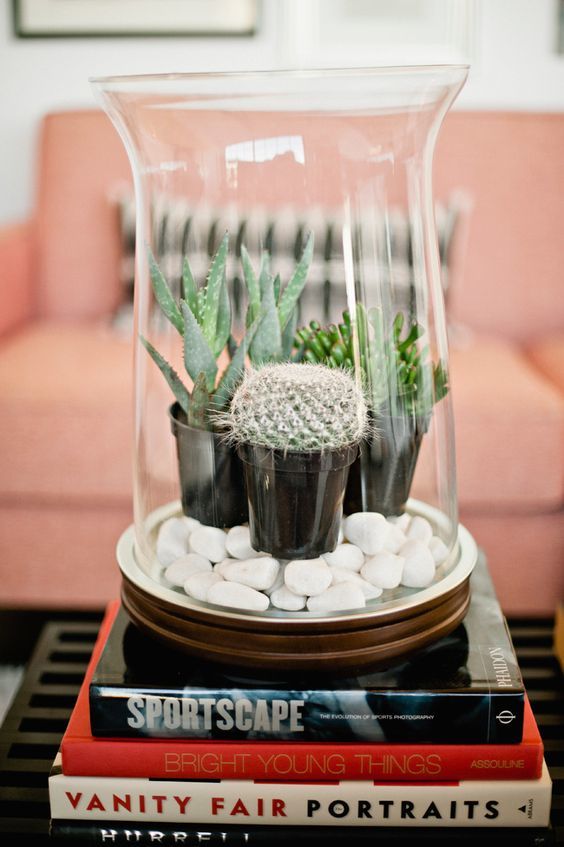

With the help of cacti, you can also create a colorful mini Zen garden in the interior. To do this, cover the top layer of soil with fine sand and, using any stick, draw geometric patterns on the sand. This composition with mesmerizing figures on the sand is perfect for dealing with stress and will help you relax after a hard day. You can watch a master class on creating a miniature Zen garden with your own hands.
Choosing cacti for the florarium
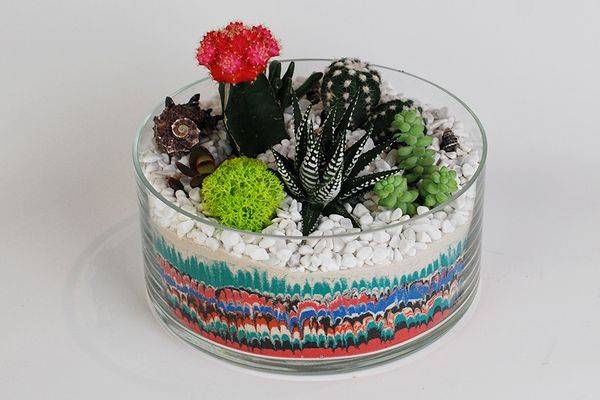

A succulent or cactus florarium is considered a unique way of landscaping an apartment. The flower arrangement, placed in a glass flask or any other transparent container with a tapered top, attracts attention with its originality and interesting design. Unlike a flower terrarium, which is often placed in a rectangular, square or round glass container, a cactus in a glass flask looks more interesting and stylish.
Many novice cactusists are interested in how to choose the right plant components to create a florarium with their own hands. Please note that due to its shape (we are talking about a glass flask with a narrowed neck), a special microclimate is formed inside the florarium, where a certain level of humidity and temperature regime is maintained. For this reason, as recommended by experts in the field of floristry and interior design, when choosing plants for a florarium, it is necessary to take a closer look at those crops that are distinguished by their unpretentious care.
So, to fill the flower florarium, you can use moss, fern, orchids, Saintpaulias, cyclamens and various varieties of succulents. In nature, there are more than 15 thousand varieties of cacti, but not all of them are suitable for growing in florariums. The best option are echinopsis, rebutia, prickly pear, notocactus and other varieties of succulents, which are compact in size and have minimal requirements in terms of care and maintenance.
DIY step-by-step instructions
General recommendations
- The thickness of the soil layer is determined taking into account the size of the florarium and the root system of plants. On average, it is 5–6 cm.
- The optimum thickness of the charcoal interlayer is 1 cm. This is quite enough for disinfection.
- All florariums should be protected from direct sunlight to avoid plant burns.
- The remains of dead plants can be used as fertilizer.
Florarium for beginners in a glass jar
Materials and tools:
- Glass jar.
- Fresh and dry moss.
- Activated or regular charcoal for disinfection.
- Drainage (expanded clay, broken brick, sand).
- Tweezers.
- Priming.
- Decorations.
Algorithm of actions:
- We spread the drainage.
- Put dry moss on top of it (it is needed to absorb excess moisture).
- We fill in the soil and level it with a spoon.
- We plant moss.
- We decorate the florarium to your liking.
Instead of or paired with moss, you can plant a suitable plant of your choice.
Open florarium in the aquarium
Materials and tools:
- Drainage.
- Suitable plant.
- The soil.
- Activated and charcoal.
- The spoon.
- Tweezers.
- Spray.
- Decorations.
Algorithm of actions:
- Degrease the container.
- We place the drainage.
- Pour in activated carbon (it is needed to prevent mold growth).
- We spread the soil.
- We spread the contents with a spoon.
- Using tweezers, carefully plant the plants.
- We spray them from a spray bottle.
- Add the selected decorations.
Succulent plants in a geometric vessel
Materials and tools:
- The vessel is a polygon.
- Soil for succulents.
- Activated carbon.
- Drainage.
- Succulent plants.
- Moss sphagnum.
- Decorations.
Algorithm of actions:
- We spread the drainage.
- Add crushed activated carbon for disinfection.
- We put the soil and level it.
- We plant the plants at a distance of 2-3 cm from each other so that they do not start to rot upon contact.
It is better to decorate such a florarium with pebbles - they will look better with succulents.
Floriana in a light bulb
Materials and tools:
- Burnt out light bulb.
- Protective glasses.
- Pliers.
- Screwdriver
- Tweezers.
- Funnel.
- Plants (it is better to take chlorophytum or succulents).
- Sand (if you disinfect it, then mold does not form in it, so you can do without coal; there is not enough space in the light bulb).
- Moss.
- Decorations.
Algorithm of actions:
- Remove the base from the lamp with pliers.
- We take out the rest of the parts with tweezers.
- Use a funnel to fill in the sand.
- We plant the plants.
- Lay moss and decorations around.
You can water such a florarium no more than once a month.
Video: how to make a mini-garden - master class
Comments and questions about this video:
In this video tutorial on floristry, I will show you how to make a composition of indoor plants in a glass vase called a florarium.
For planting plants in the florarium, plant species should be selected that will have approximately the same requirements for growing conditions: humidity, illumination and soil composition.
The composition can be created in a wide variety of glass vessels, in all kinds of shapes and sizes.
To make a composition, I will need: a spherical vase with a volume of 7.5 liters, drainage "shards", peat, sand, coal, a set of tools, gloves, a watering can with water, a skewer, decor (bird, pebbles, sand). I will plant moisture-loving plants in the florarium (Fittonia, Dracaena, Cheder).
So let's get started.
The first step is to prepare the soil for our plants. To do this, mix the peat with sand.
We take the aquarium. Before planting plants in it, the aquarium must be thoroughly washed and disinfected, for example with vodka. I have already done this in advance, so we proceed to planting.
I pour shards of drainage at the bottom, then a layer of charcoal, it will protect the plants from mold and rot. After that, we fill in the soil prepared in advance "peat with sand", a layer of about 5-7 cm. We make depressions for our plants.
We take out the plants from the pots, shake off the soil from the roots a little. And one by one, we plant the plants. After the plants have been planted, you need to pour them a little with water at room temperature, using a watering can with a shower head.
Let's get started with the decor. We decorate our composition with colored pebbles, sand and a decorative bird.
The florarium is ready. The result is a wonderful interior composition.
Like, comment and subscribe to our new videos.
Anna Fedosova and the Open-Flower project were with you.
What is a terrarium in a bank and a florarium?
In general, a plant terrarium or florarium is an ordinary aquarium, only instead of water and fish there are plants in it. The progenitor of florariums can be called the English scientist Nathaniel Ward, who at the beginning of the 18th century placed tropical plants in a closed space (ward's box), thereby creating the most favorable conditions for them.
Since then, plants that are not used to the cold climate have been imported to different countries of the world and grown in specially equipped greenhouses, conservatories or pavilions. It was not possible for everyone to equip a large greenhouse at home, and therefore mini-gardens with plants became widespread. In florariums, mainly small plants or dwarf plants for the home are grown, otherwise the filling of the glass garden would have to be changed too often. Thus, having properly arranged the microclimate inside it, a closed ecosystem in a bottle is formed and you create an almost eternal terrarium in a bottle with your own hands!
Mini-gardens: features, the choice of composition and the creation of a garden of cacti and succulents with your own hands
Creating and growing gardens is an interesting and rewarding activity.Not everyone can grow a garden or equip a personal plot. It takes skill, practice, time and effort. It's easier to create a miniature potted garden with your own hands. This type of ornamental gardening is very popular. The creation of a mini-garden will not take time and effort, but it will bring pleasure from work and the joy of contemplating your own creation.
An inexperienced gardener can start with a DIY mini garden of cacti and succulents. It is not difficult to create compositions from succulents with your own hands.
These plants get along well with each other, are unpretentious and require minimal care. In order for a mini-potted garden to retain its original structure for a long time, it is necessary to select varieties that grow at the same rate.
Preparing for landing
Making a mini-garden in a pot with your own hands requires preparation. For this you need:
- choose a place;
- think over the composition;
- pick up a pot or other container;
- choose plants;
- prepare soil and drainage;
- pick up decor.
Seat selection
Estimate the distance from which the garden will open in all its glory. The greater the distance, the larger the composition should be.
Cacti and succulents love the sun. You need direct sunlight for two hours a day, no less. With a lack of light, the stems of plants are bent.
If the garden is planned to be placed not on the windowsill, then it is necessary to be guided by the rule: the less light, the lower the temperature and the drier the soil should be.
Gallery: mini-garden of cacti and succulents (25 photos)
Composition
The type of garden depends on the location. If the sides are viewed the same way, create a circular composition in the form of a small slide. If the gaze falls from above, then a flat "lawn" structure will do.
Groundcover or creeping succulents
Gardeners, landscape designers know plants that are called ground cover species. Their essence is that these undersized, and sometimes creeping seedlings are actively spreading over the area, capturing the territory in a special way. It turns out a kind of carpet of creeping succulents.
Sedum
Succulents: home care and the main types of the family
This flowering beautiful plant came to the middle latitudes, like other succulents, from dry American, African, Eurasian regions.
Note! In addition to decorative features, sedum (another name is sedum) is known as a medicinal pain reliever that heals burns and wounds. Extracts from stonecrop juice are widely used in the manufacture of medicines, as well as for culinary purposes.
Survives drought due to its natural ability to absorb and retain water in the leaves. The stems of the sedum are erect, up to 80 cm high, with inflorescences of different shades and shapes.
Diseases and pests of succulents
Beautiful undemanding plants have earned popularity due to their bizarre shapes and ease of care. But they can get sick from improper care, damage by insects or fungi, rot.
Therefore, it is necessary:
- observe the regime of watering, replenishment;
- provide the bottom of the landing pit with a drainage mixture;
- there should be a hole at the bottom of the vase;
- propagate vegetatively in spring and summer with cuttings aging before planting for several days in the air, thereby protecting against the penetration of parasites into the cut.
Distribution in gardens, parks of succulents is justified. The originality, uniqueness of natural creation creates a good mood, ennobling the territory. The main thing is to choose the right types of plants and provide them with proper care.
Features of further care
If you think that cacti grown in a closed or open florarium do not require attention and care, you are greatly mistaken. For normal life, the plant must be periodically watered, fed with fertilizers and examined for signs of any diseases and harmful insects.
Closed containers need to be opened from time to time so that the plants grown there can receive oxygen. Do not forget to keep the florarium clean.
grow-
Compositions of succulents in glass: options for florariums
Before making a florarium with your own hands, it is worth evaluating the variety of existing models in order to choose the most suitable solution for the interior. All florariums can be divided into three groups:
- Florariums of the aquarium type, when the compositions are created in real aquariums, are considered the most suitable for organizing an independent ecosystem, since they have a cover and lighting.
- Glass jars, vases for florarium and glasses of various shapes and configurations. You can buy a special container for the florarium on the Internet, however, buying the most expensive one is not at all necessary.
- The bottle version is spectacular, but the most difficult to manufacture, since it is difficult to plant and care for plants through a narrow neck.
Advice! You should not choose a container for a florarium in terms of beauty or size. Both in the aquarium and in glassware, you can create real masterpieces even in the smallest space. It is the miniature containers with 3-4 plants inside that look very impressive.
Florariums can be located in different ways: they are mounted on walls, placed on a table or window sill, suspended from the ceiling, etc.
The filling of the florarium can also be completely different, however, it is necessary to choose for the joint cultivation of those representatives of the flora that require the same conditions. This allows you to create real natural zones in miniature in glassware: a mountain landscape, desert plants, tropics or a piece of a dense forest.
Monobouquet.
Simple, stylish and sophisticated. Style is in simplicity, and “Simplicity is the key to true elegance” - Coco Chanel. Take Meghan Markle, Prince Harry's fiancée, for example. In her image
everything is so simple, but at the same time the best English designers worked on it.
- Suitable for any look.
- Low cost.
Here it is important to consider the choice of the rest of the wedding floristry. Boutonniere for the groom or wreaths for girls, flowers in the hairstyle of bridesmaids - there are many options
.
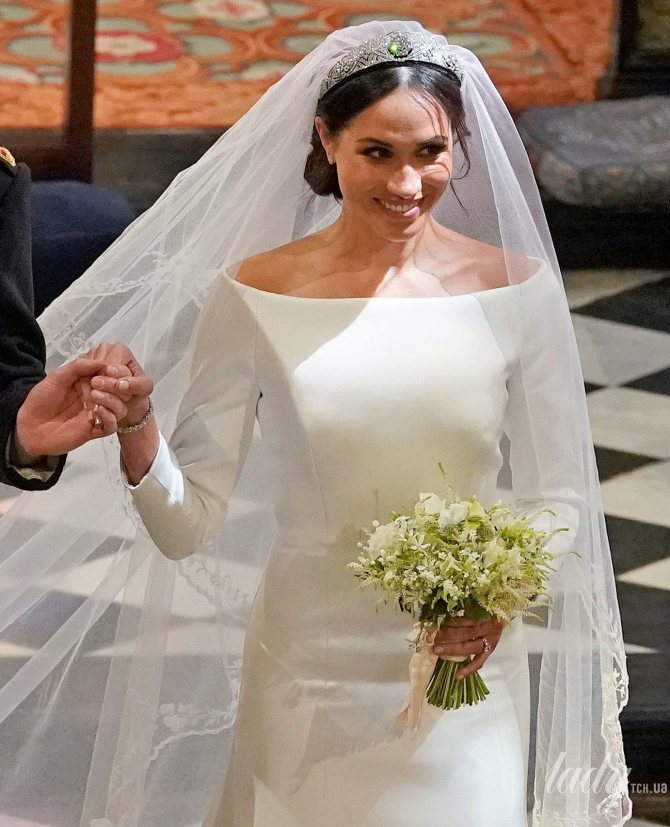

Master class, step-by-step instructions with a photo:
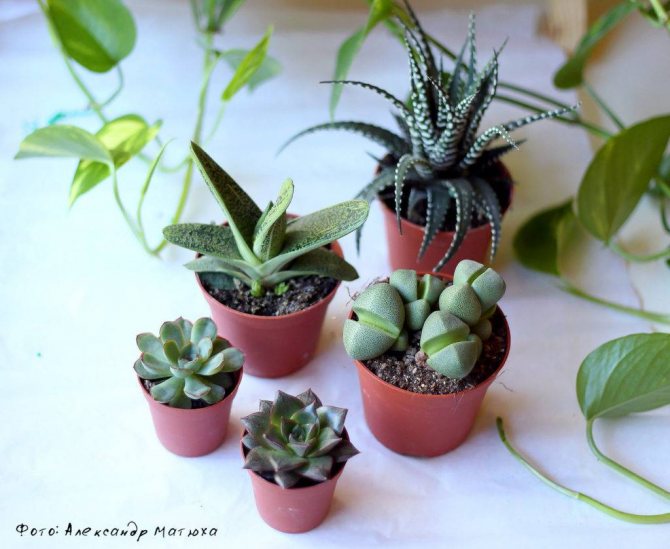

- What do we need to fill the florarium?
- Plants, substrate and drainage are required to fill the florarium. Read which succulents are best for you. Usually succulents are planted, or vice versa, moisture-loving plants. For the second, florariums with a lid are more suitable, inside which the optimal air humidity will be constantly maintained. It is also worth considering that such plants need a larger capacity than succulents, and the substrate must be sufficiently nutritious.
For succulents, florariums of various sizes and volumes are suitable, since they grow rather slowly and feel great on poor substrates - sand and gravel.
Due to their unpretentiousness, succulents are more popular, therefore, by their example, it is worth talking about planting plants in the florarium.
An extremely important component of the florarium is drainage... It sounds proudly for sealed containers, but the problem of stagnant water must be solved. This can be done using various hygroscopic materials; fine expanded clay and hydrogel can be used. It is also necessary to use activated carbon, which is used in filter columns and filters for aquariums. Coal for a long time does not allow the walls of the florarium to "bloom" - to develop algae.
- Which substrate is suitable?
- As already mentioned, gravel and sand-gravel crops are perfect for growing succulents. Both sand and gravel can be purchased at the store, or collected with your own hands on the seashore (especially when it is nearby)
The collected material must be processed, it is best to ignite it in an old unnecessary frying pan or baking sheet in the oven. Purchased materials are easy to rinse.
Purchased materials can be painted and unpainted, quarried or otherwise - for every taste.
Substrate for filling the florarium - sand, drainage, hydrogel, activated carbon
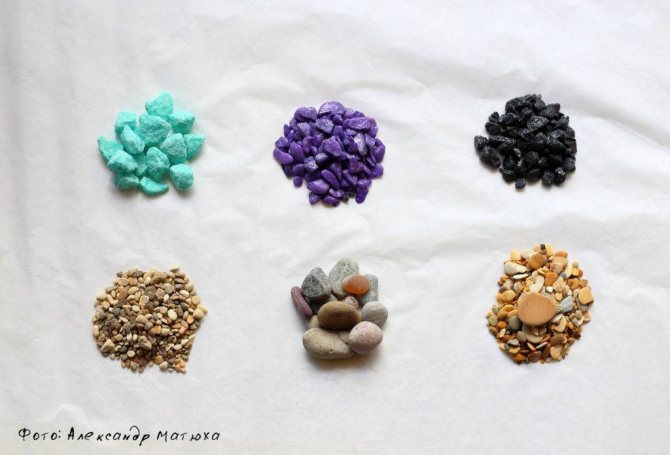

Colored pebbles, pebbles and gravel
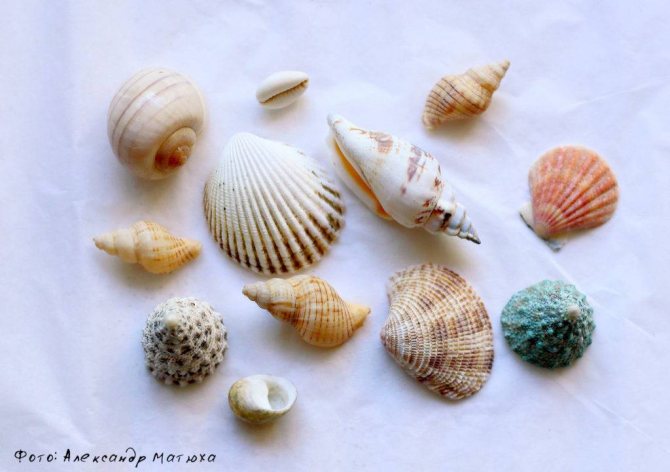

Shells for decoration
- What plants are suitable for the florarium?
- Small cacti, haworthia, echeveria, lithops, sedum and crassula perfectly coexist in glass.
- How to properly plant a plant in a glass vase?
- Planting is carried out in several stages:
- First you need to thoroughly wipe and polish the vase itself using a glass cleaner. If we are talking about the florarium, made in the Tiffany technique, then take care of the platinum at the seams, try not to chip or scratch it.
Tip: work with latex gloves, otherwise rubbing one edge, you will definitely leave marks on the next.
- Prepare everything you need before planting: get the plants from technical pots and rinse the roots in warm water, choose the substrate in accordance with your idea - everything should be at hand.
- First, it is necessary to pour a sand cushion on the bottom (so that coarse gravel and expanded clay does not leave deep scratches on the bottom edge). Place expanded clay in the center, add hydrogel and activated carbon. Lay out the side edges with gravel. Place the plants in the resulting "bowl" and cover the gaps with gravel.
Succulents - outdoor perennials
Only plants with special tissues capable of storing water can survive in regions with difficult arid climates. People have learned to grow succulents in a supportive home environment. Succulents on the street are still used as an exotic decoration. Bright cactus flowers and fleshy leaves, unusual in appearance, decorate, enliven sunny gardens. Unusual potted compositions, skillfully composed of different types of succulents, began to appear more often on the streets.
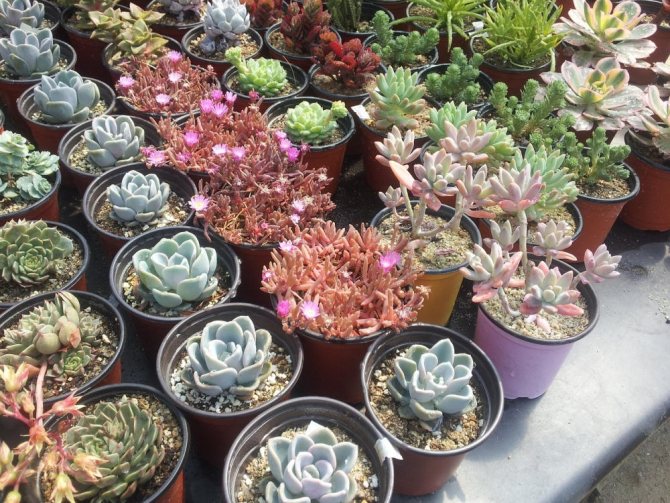

Potted compositions on the street
Levisia
Among succulents, a low bush, strewn with large, ball-like inflorescences, occupies a special place. This is levisia. The plant is characterized by the resemblance to a live bouquet. A combination of numerous colors and shades came together in a small drought-resistant bush.
Rejuvenated
The flower rejuvenates is an ideal succulent for creating alpine slides, their lower tier. During flowering, it is especially similar to a thornless cactus that happened to be in the Middle Lane. Growing young, propagating an exotic plant is not difficult, it can take root in any soil, even without roots.
Bacopa
Bacopa ampelous grown in hanging baskets looks original in street design. Its uniqueness is expressed in small leaves and flowers of different colors (blue, white, pink). These creeping succulents are able to form a root system wherever the shoots come into contact with the soil. A wonderful combination of colors and shapes is obtained in the vicinity of other floral plants. Here you can experiment as much as you like.
Dorotheanthus
This miniature South African plant has become a characteristic feature of the garden decoration. Succulents in the garden in the form of this bush transform the territory with bright flowers and unusual-looking shoots. Many growers have chosen this look, similar to the usual daisies, which begins flowering in June and ends in mid-autumn. Such a long flowering period is possible with proper care. Green leaves with shimmer, covered with shining villi, multi-colored and even two-colored buds emphasize the unusualness of the peduncles.
Aptenia
The South African and South American continents presented another evergreen plant called aptenia.The peculiarity is expressed in the name, which in Greek means that aptenia blooms at noon. The name is true. The fleshy leaves of a bright green wedge-shaped shape with smooth edges are oppositely arranged. Small round flowers bloom in their sinuses, highlighting in all shades of purple.
For your information! When succulents in the country finish flowering, seed pods appear in their place.
Delosperma
It stands out among succulents by the appearance of unusual salt crystals on a green surface, which resembles an ice cover on leaves. Low shrubs are covered at the time of flowering with a bright multicolored scattering of petals. At home, they grow like perennial succulents, only some species manage to survive the winter in summer cottage garden plantings.
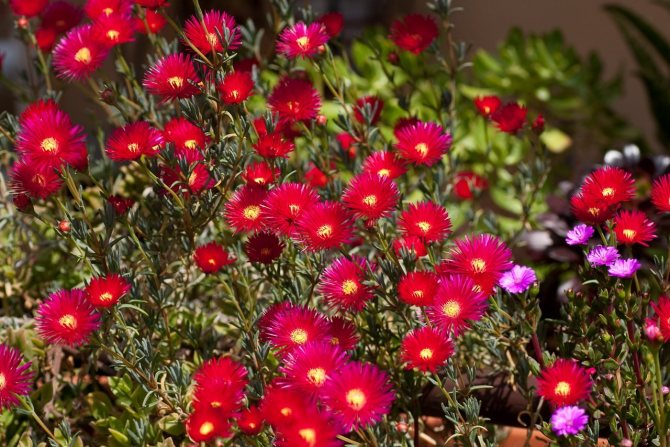

Delosperma is a representative of the succulent genus
Spurge myrtle
Gardeners fell in love with Euphorbia for its beauty, undemanding conditions. There are known varieties of annuals and perennials, evergreen bushes and tree-like frost-resistant plantings. Spurge with its decorativeness and originality contributes to the design of borders, flower beds. It is used in garden or park areas when creating a rocky slide or rock garden. Various plants are planted there along with milkweed.
Ragwort
The number of flowering varieties is great, the most numerous among them is the genus of the Cross, numbering about 1200 species. Some of them are attracted by their unusual silvery foliage, the other part has bright flowers, similar to familiar chamomile, the third part best decorates, for example, the coastline of a dacha pond. Grasses stand out from the species diversity. There are known tree-like wild plants (African species), shrubs, and lianas.
For your information! Some similarities with watercress gave the name to the plant in the Russian manner.
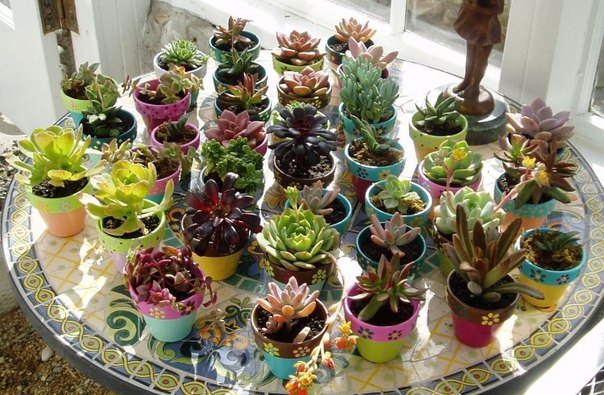

Variety of species

